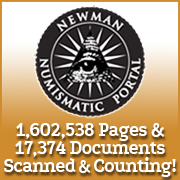
About UsThe Numismatic Bibliomania Society is a non-profit organization devoted to the study and enjoyment of numismatic literature. For more information please see our web site at coinbooks.org SubscriptionsThose wishing to become new E-Sylum subscribers (or wishing to Unsubscribe) can go to the following web page link MembershipThere is a membership application available on the web site Membership Application To join, print the application and return it with your check to the address printed on the application. Print/Digital membership is $40 to addresses in the U.S., and $60 elsewhere. A digital-only membership is available for $25. For those without web access, write to: Terry White, Treasurer AsylumFor Asylum mailing address changes and other membership questions, contact Terry at this email address: terrywhite5475@yahoo.com SubmissionsTo submit items for publication in The E-Sylum, just Reply to this message, or write to the Editor at this address: whomren@gmail.com BUY THE BOOK BEFORE THE COINSale Calendar |
- WAYNE'S WORDS: THE E-SYLUM NOVEMBER 15, 2017
- BURD LIBRARY HIGHLIGHTS: ANCIENT NUMISMATICS
- NEW BOOK: COINAGE OF CHARLES FERDINAND VASA (1613-1655)
- NEW BOOK: 2018 CANADIAN GOVERNMENT PAPER MONEY
- PENNYBOARD PRESS BOOK 2018 UPDATES AVAILABLE
- BOOK REVIEW: NINI MEDALLIONS OF BENJAMIN FRANKLIN
- ROBERT MARTIN (1946-2017)
- NEWMAN PORTAL OFFERS SEARCH BY AUCTION FIRM
- NEWMAN PORTAL SEARCH: TERLECKI
- ARTICLE HIGHLIGHTS NATIONAL NUMISMATIC COLLECTION
- HOWARD F. BOWKER EAST ASIA NUMISMATIC COLLECTION
- NOTES FROM E-SYLUM READERS: NOVEMBER 12, 2017
- ANOTHER WASHINGTON BEFORE BOSTON MEDAL PLASTER
- ELISHA KENT KANE MEDAL VARIETIES
- VOCABULARY TERM: HOT SHORTNESS
- MARQUIS DELAFAYETTE STOPHLET (1846-1920)
- CRAIG SHOLLEY ON THE CONTINENTAL DOLLARS
- BEISTLE COMPANY ANNIVERSARY ITEMS
- A NUMISMATIC SENTIMENT
- ARCHIVES INTERNATIONAL SALE 45
- SEMINAR ON THE 15TH ANNIVERSARY OF THE EURO SYSTEM
- WAYNE'S NUMISMATIC DIARY: NOVEMBER 12, 2017
- MORE ON THE SCOTNEY CASTLE COIN COLLECTION
- BULGARIAN ROMAN COIN HOARD FOUND UNDER TREE
- 1863 $5 RICHMOND IN NATIONAL BANK NOTE SOLD
- JANE AUSTEN NOTE ADVOCATE CAROLINE CRIADO-PEREZ
- THIEVES BLOW UP CASH MACHINE
- PAINTING OF 1880 $10 LEGAL TENDER NOTE OFFERED
- RICHARD SCHLATTER’S 'A. LINCOLN' PORTRAIT
- FEATURED WEB SITE: ARTMEDAL.NET
Click here to access the complete archive
To comment or submit articles, reply to whomren@gmail.com
Content presented in The E-Sylum is not necessarily researched or independently fact-checked, and views expressed do not necessarily represent those of the Numismatic Bibliomania Society.
WAYNE'S WORDS: THE E-SYLUM NOVEMBER 15, 2017
This week we open with literature on ancient numismatics from the Burd library, two new books, one review, remembrances of colonial collector Robert Martin, and updates from the Newman Numismatic Portal.
Other topics this week include the national Numismatic Collection, Howard Bowker's East Asia collection, the anniversary of the euro monetary system, a Bulgarian Roman coin hoard, the Scotney Castle collection, and Richard Schlatter's Lincoln portrait
To learn more about Louis XIV’s collection of ancient coins, Canadian Government paper money, Connecticut coppers, Wladyslaw Terlecki, the Ferracute Machine Company, the U.S. Mint Numismatic Library, the Elisha Kent Kane medal, the Canadian Bank of Commerce, the 1870 2nd edition Maris pamphlet, Jane Austen note advocate Caroline Criado-Perez, and hot shortness, read on. Have a great week, everyone!
Wayne Homren
Editor, The E-Sylum
BURD LIBRARY HIGHLIGHTS: ANCIENT NUMISMATICS
HIGHLIGHTS FROM THE WILLIAM A. BURD LIBRARY: ANCIENT NUMISMATICS
Kolbe & Fanning Numismatic Booksellers will be offering highlights from the outstanding numismatic library formed by Chicagoan William A. Burd in our 2018 New York Book Auction, which will be held in conjunction with the New York International Numismatic Convention on Saturday, January 13, 2018 at the Grand Hyatt hotel in Manhattan.
We have been working on the catalogue for the auction for some time now, and wanted to give readers a small preview of what they have to look forward to. The following are some highlights from the Burd Library’s offerings of material on ancient coins:


Lots 22 and 39
Lot 22: a lovely copy of Boehringer on Syracuse
Lot 39: a beautifully bound original set of Delgado on ancient coins of the Iberian peninsula
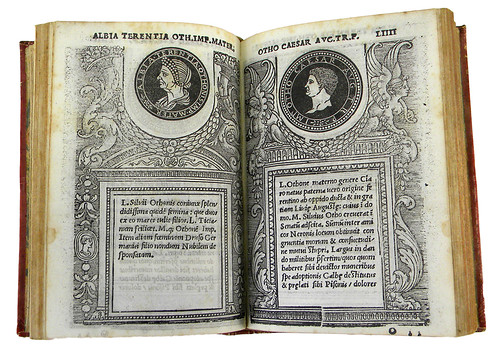
Lot 47
Lot 47: the first edition of the first printed book substantially illustrating coins & medals, Fulvio’s 1517 Illustrium Imagines (celebrating its 500th anniversary on November 15!)
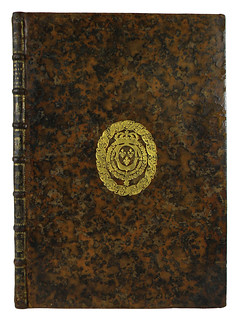
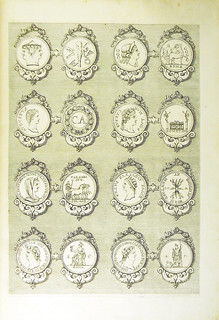
Lot 72
Lot 72: a bound set of the extremely rare engraved plates depicting Louis XIV’s collection of ancient coins
Lot 101: over 100 volumes of the Numismatic Chronicle
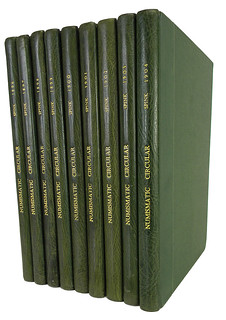
Lot 115
Lot 115: an exceptional set of Spink’s Numismatic Circular
Lot 116: Hans von Fritz’s inscribed set of Svoronos on the Ptolemies
Lot 118: Svoronos and Pick’s Les Monnaies d’Athènes
Lot 119: an original set of the Sylloge Nummorum Graecorum series on the Royal Danish collection at Copenhagen
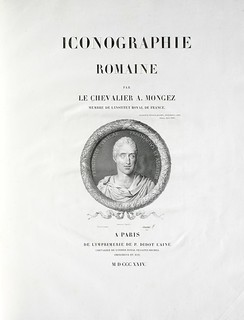
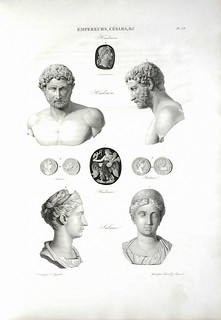
Lot 131
Lot 131: an exceptional, complete set of Visconti & Mongez’s truly monumental Iconographie Grecque et Romaine
Later press releases will cover highlights from the Burd Library’s books on foreign and American numismatics. The online catalogue for our New York Book Auction will be available by the end of the month. Printed catalogues will be available in December.
Kolbe & Fanning Numismatic Booksellers are a licensed auction firm specializing in the sale of rare and out-of-print numismatic literature. We also sell new and secondhand numismatic books on a retail basis through our website at numislit.com. To subscribe to our email list, please see numislit.com or contact David Fanning at df@numislit.com.
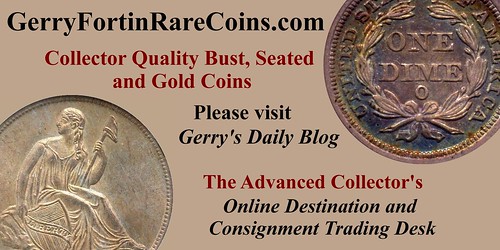
NEW BOOK: COINAGE OF CHARLES FERDINAND VASA (1613-1655)
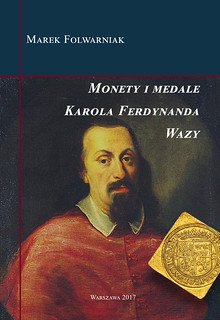 Marek Folwarniak, Monety i medale Karola Ferdynanda Wazy. Polskie Towarzystwo Numizmatyczne, Warsaw 2017. 84 pages with color illustrations, paperback, 16.5 x 24 cm. ISBN:
978-83-945110-2-9. 30 zloty (ca. 7 euros) + postage.
Marek Folwarniak, Monety i medale Karola Ferdynanda Wazy. Polskie Towarzystwo Numizmatyczne, Warsaw 2017. 84 pages with color illustrations, paperback, 16.5 x 24 cm. ISBN:
978-83-945110-2-9. 30 zloty (ca. 7 euros) + postage.
The book “Monety i medale Karola Ferdynanda Wazy” [The coins and medals of Charles Ferdinand Vasa] discusses the numismatic legacy of the Polish prince and bishop, one of the sons of the king Sigismund III Vasa.
Charles Ferdinand Vasa was not interested in politics but he was a great supporter of arts and a collector of art, coins and medals. He left behind substantial wealth and an extensive numismatic collection including coins and medals minted in his name.
The author presents, verifies and, in many cases, questions earlier knowledge of coinage of Charles Ferdinand Vasa. He manages to bring to light several new variants of his coinage not described in the literature. It is a thorough source for study of the coinage of the Vasa dynasty.
For more information, see:
Nowe wydawnictwo PTN – Monety i medale Karola Ferdynanda Wazy
(http://ptn.pl/2017/06/27/nowe-wydawnictwo-ptn-monety-medale-karola-ferdynanda-wazy/)
To read the CoinsWeekly article, see:
Catalogue of the coinage of Charles Ferdinand Vasa (1613-1655)
(http://www.coinsweekly.com/en/News/Catalogue-of-the-coinage-of-Charles-Ferdinand-Vasa-1613-1655/4?&id=5026)
NEW BOOK: 2018 CANADIAN GOVERNMENT PAPER MONEY
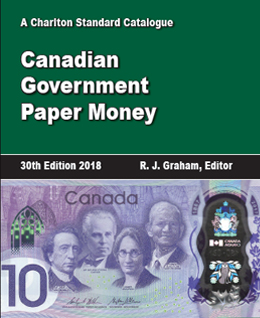 2018 Canadian Government Paper Money 30th Ed.
2018 Canadian Government Paper Money 30th Ed.
Author: R.J. Graham Price: CDN $34.95 US $29.95 UK £0.00
Release Date: 2017
448 pages
Dimensions: 7 x 9
ISBN: 9780889684072
From French Regime card money and War of 1812 Army Bills through to the Bank of Canada’s latest Canada 150 polymer note, Canadian Government Paper Money describes and prices issues from all levels of government, including provincial and municipal issues of colonial times and 1930s Depression Scrip. Almost all notes are illustrated in full colour. Tips for collectors are provided for many issues which offer updated note census information and other useful facts not always available from other sources.
The grading guide includes grading standards for polymer notes. Latest valuations are provided in up to eight grades. The market for Dominion of Canada and Bank of Canada notes continues in a somewhat subdued state, but this edition nevertheless includes over 1,400 individual price changes, of which over 1,000 are increases, generally modest. Drastic changes are few, mainly affecting rare non-circulating material, for which the market will not support high levels established earlier.
For more information, or to order, see:
2018 Canadian Government Paper Money 30th Ed.
(http://www.charltonpress.com/NumismaticsBook.asp?v_ISBN=9780889684072)
PENNYBOARD PRESS BOOK 2018 UPDATES AVAILABLE
Available now are 2018 update documents for all PennyBoard Press books. These include Coin Collecting Boards of the 1930s & 1940s; Coin Collecting Albums Volume One - Products of Beistle, Raymond and Meghrig; and Coin Collecting Albums Volume Two - Library of Coins & Treasury of Coins.
These documents, which feature all revisions and new varieties, will sent free of charge in PDF format to anyone requesting them by email to DavidWLange@outlook.com. The coin board book documents also include an updated Check List & Value Guide reflecting new pricing for 2018.
Persons wishing to receive printed copies should send a self-addressed and stamped envelope to the address below, specifying the book(s) for which an update list is desired.
David W. Lange
POB 110022
Lakewood Ranch, FL 34211
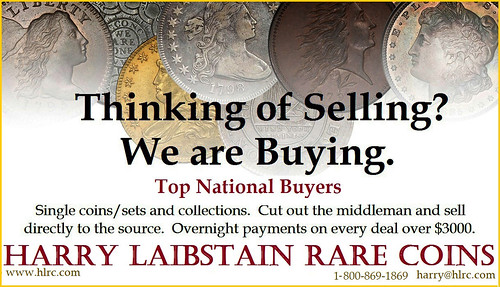
BOOK REVIEW: NINI MEDALLIONS OF BENJAMIN FRANKLIN
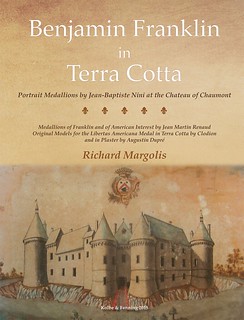 MARGOLIS BOOK ON NINI MEDALLIONS OF BENJAMIN FRANKLIN REVIEWED IN ACADEMIC JOURNAL
MARGOLIS BOOK ON NINI MEDALLIONS OF BENJAMIN FRANKLIN REVIEWED IN ACADEMIC JOURNAL
Carla J. Mulford, one of the nation’s pre-eminent scholars of Benjamin Franklin, recently published a review of Richard Margolis’s book Benjamin Franklin in Terra Cotta in the important journal Early American Literature (Vol. 52, No. 3, 2017, pp. 729-748). Margolis’s book painstakingly traces the history and production of the medallions produced by Jean-Baptiste Nini depicting the popular American statesman, printer, scientist and diplomat. Mulford’s review is very positive, and at times is downright effusive. This is especially notable coming from such a serious, scholarly journal.
In discussing three recent publications on Franklin, Mulford writes, “Of the three, the Margolis volume is the most original: it is a thoroughly readable and original scholarly study, featuring Margolis’s immense research in archival and material evidence that has never before been collected and presented in a single volume.” She continues, writing that “Margolis’s book will likely stand for the next several hundred years as the definitive study of the masterworks of the Nini pottery at Chateau-sur-Loire. The volume is just an amazing achievement. It leaves me, an owner of three of Nini’s medallions, spellbound with admiration for the range and complexity of Margolis’s original research.”
A preview of the review essay can be found at https://muse.jhu.edu/article/675673 .
Benjamin Franklin in Terra Cotta is published by Kolbe & Fanning Numismatic Booksellers and can be ordered at: https://www.numislit.com/pages/books/3473 .
For more information, see:
NEW BOOK: BENJAMIN FRANKLIN IN TERRA COTTA (http://www.coinbooks.org/esylum_v18n10a03.html)
ROBERT MARTIN (1946-2017)
Randy Clark of San Jose, CA writes:
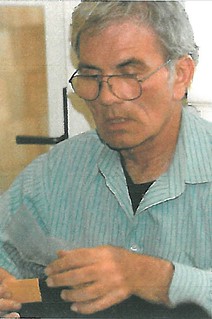 Robert Martin was a avid collector during several numismatic generations. He started with Large Cents in the 1960s and 70s as a member of Early American Coppers, Inc (after serving his
country in Vietnam), and always prided himself as having a very early EAC membership number. As prices for Federal copper grew, he became an early enthusiast of Colonial Coins, and in the 1970s and
1980s began focusing on Connecticut coppers (and Massacusetts Silver). He had many peers in the early days of the Colonial Coin Collectors club (C4) organization who sought his opinions, knowledge
and friendship.
Robert Martin was a avid collector during several numismatic generations. He started with Large Cents in the 1960s and 70s as a member of Early American Coppers, Inc (after serving his
country in Vietnam), and always prided himself as having a very early EAC membership number. As prices for Federal copper grew, he became an early enthusiast of Colonial Coins, and in the 1970s and
1980s began focusing on Connecticut coppers (and Massacusetts Silver). He had many peers in the early days of the Colonial Coin Collectors club (C4) organization who sought his opinions, knowledge
and friendship.
In the 1990s and 2000s he cultivated and taught a new crop of colonial collectors and researchers (myself included), particularly those focusing on his favored Connecticut coppers. Robert was a strong advocate of "color & surfaces" when choosing his coins, and was a master of knowing Connecticut copper "condition - rarity", focusing on the best pieces of each variety that only those with knowledge depth could identify. Robert was always pleasant, fair and willing to talk your ear off if you let him. I considered him a great friend and hobby mentor .. and he will be greatly missed.
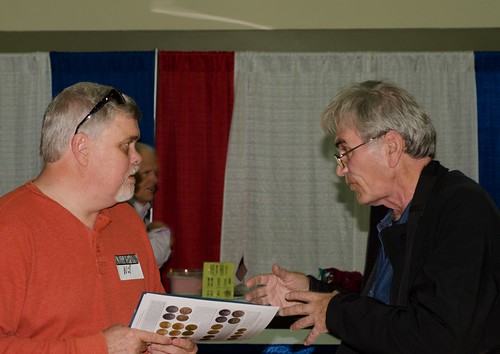
C4 Baltimore 2014 Will Nipper and Robert Martin
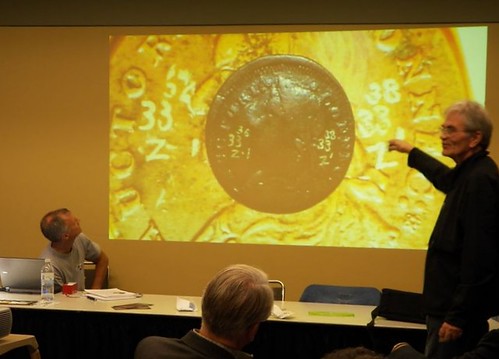
C4 Baltimore 2014 Randy Clark and Robert Martin
Mike Packard writes:
Robert was an EAC and then a C4 fixture. His areas of expertise were Mass silver and Connecticut coppers, and he was extraordinarily knowledgeable in both areas. He was my age, and we were both in the Army at the same time in the late 60s. However, he went to Vietnam and I went to Germany. I used to call him up whenever I found a rare or scarce Connecticut, and I don't think our conversations ever lasted less than 90 minutes--and I am a pretty quiet guy. He kept meticulous records on appearances all 360 or so Connecticut varieties.
Our talks would begin with me telling him what I found, where I found it, and how I graded it. He would then tell me how many examples he was aware of if there were fewer than 30 or so examples known to him, and where he thought my coin fit into the series. And then he would be off with wonderful stories of Hall, Miller, Canfield, Barnsley, and others who collected Connecticut coppers. Absolutely fascinating stuff. I truly regret I did not call him more often and that I was not able to tape our calls. He was a wonderful person and I will miss him.
Anthony Terranova of New York City writes:
I will miss my friend Bobby very much. Early in my days as a dealer we would always compare what we observed as far as condition goes, to make sure we weren't seeing things as too nice. I always took Bobby's eyeball observations as a positive validation of my own eye.
Mary Ann Terranova writes:
I knew Bobbie before for a long time. He was teaching me about colonial coppers. He took me into the city to view coins being readied for auction. It was at Stack's that he introduced me to my husband-to-be Anthony Terranova. It was Bobbie's love of Connecticut Coppers that drew me to them. He was scholarly and patient. A good friend. He will be missed in the coin world as well as mine.
Roger Siboni writes:
This week Colonial numismatics lost one of its brightest lights and best of friends. Sadly, Robert Martin passed away last Thursday from cancer complications and all of us in the Colonial world will miss the tremendous impact he had on each of us whether direct or indirect. While Robert was widely known as the master of Connecticut coppers for our generation, maintaining meticulous records of virtually every Connecticut copper that passed through any auction house, fixed price list, or major collectors hands. His interests and knowledge spread much further and wider than what he was so well known for. He was a serious student of Massachusetts Silver, with a particular interest in Feversham cut coinage, Regulated Gold, painted die varieties, Machin's Mills coinage, Vermont coppers, numismatic literature and the list goes on.
Robert was an ANS Fellow from the Bronx, and in his own very unique "Christopher Walken" gait and style of talking he would always be easily picked out on a bourse floor or in an auction room. He had a ready smile and quick wit, and walked through life sharing and absorbing every bit of Colonial numismatic information the world, but particularly the New York metropolitan area, had to offer. The list of who he consulted or would consult with is just too long to enumerate, but here are just a few of those passed: Walter Breen, Gordon Frost, David Sonderman, Steve Tannenbaum, and Mike Ringo. And among those still with us, Michael Hodder, John Kleeberg, Tony Terranova, Richard August, David Menchel, Mark Borkhardt........I could go on. But suffice it to say, very few Colonial Connecticut catalogues, articles, books, transactions, attributions, authentications would ever happen without consulting Robert.
On a fairly modest budget, he assembled one of the finest collections of choice Colonial coinage just through his tremendous knowledge, uncanny memory, exquisite taste and amazing library. And on the latter score, Robert had a nose for which sales would survive the test of time. So while some of us would save one Norweb or EAC 1975, Robert would keep 20. At one time he had five Crosby's, a half dozen Halls, a dozen Wurtzbachs, a closet full of complete New Netherland runs, a dozen Sterns and Ropers. Robert was always the "go to guy" for someone new to the hobby trying to quickly ramp up their library
Robert, we will miss you.
Jack Howes writes:
We got word that Robert had passed mid day Thursday at our Colonial Coin Collectors Convention in Baltimore. Robert had told me about a month earlier that he did not think he could make it this year. So, I knew then his health was seriously bad, as this gathering was one of the highlights of his year.
I've known Robert for the better part of twenty years and considered him a great friend. It is sad to think I will never speak with him again. I have many memories of the stories he would tell. Robert had talked in recent years of moving from his apartment in the Bronx to a condo outside the city but I don't think his heart was in it. He was a New Yorker.
Robert was an avid collector of Numismatic Literature (that had at least some Colonial numismatic content). He was meticulous in his research and has a core library of Connecticut state copper research that I hope survives. He never embraced the digital world in any serious way, so this material is all "analog." He cut and pasted and typed his notes for all his research into binders. Many, many linear feet of handcrafted work.
Robert collected numismatic catalogs also. And since the mid to late 1970s he attended most auctions with colonial interest that were held in New York City and many were. He would leave with many leftover duplicates. One of my favorite stories he told was of his "cave-in" room. "What, I asked, is a 'cave-in' room"? He told me he had dedicated one room (more a large closet I believe) in his apartment for modern catalogues. One day he left the door open and a couple of his cats got in and chased each other over the stacks of catalogs, tipping them into the middle of the room and creating a "cave-in." Robert had closed the room off for over a decade but had been recently trying to restore "order." I don't know if he finished that task. I always picture opening the door to that room and still seeing the yellow crime scene tape crisscrossing the doorway!
On a last note Robert created his own numismatic collectibles. Rather than bookplates, Robert placed in every item he created or collected, one or more stamps or embossing. I have no idea how many different stamps he had but I have seen at least half-a-dozen. A couple are pictured below.
I have also attached a few pictures of Robert from a few years ago. The pictures from Roger Siboni's home in Mantoloking, NJ.
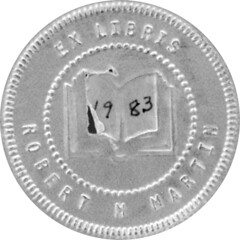
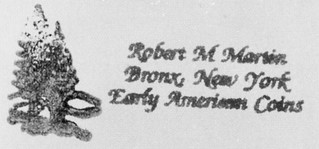
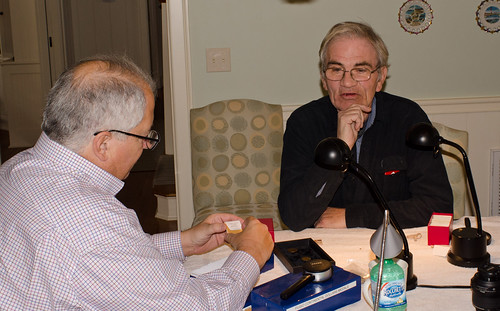
Roger Siboni and Robert Martin; Photo by Jack Howes
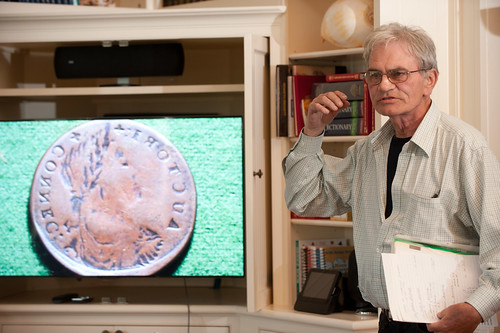
Robert Martin; Photo by Neil Rothschild
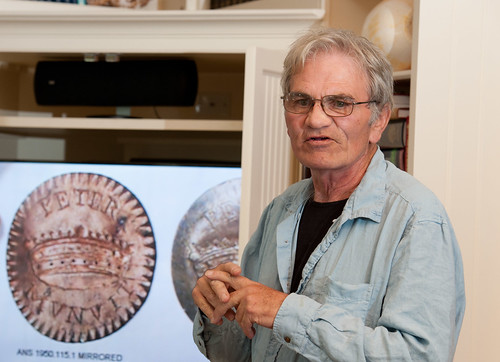
Robert Martin; Photo by Neil Rothschild
Midnight sale
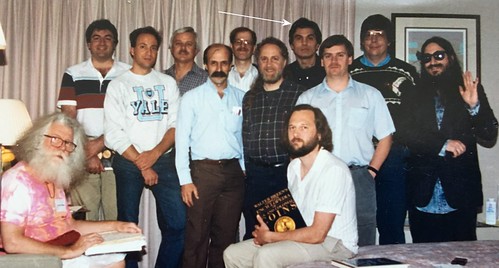
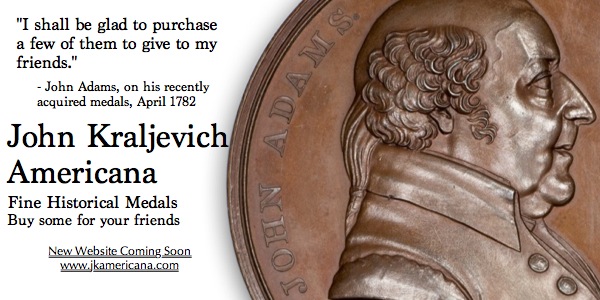
NEWMAN PORTAL OFFERS SEARCH BY AUCTION FIRM
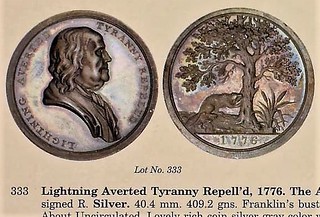
Lightning Averted, Tyranny Repelled
(Betts-546) medal (Stacks Ford XIV, May 2006, lot 333).
Newman Portal users may now perform text searches within the catalogs of a single auction firm. Simply enter the firm name in the “publisher” field of the advanced search page (the list of firms supported are on the Newman Portal auction catalogs landing page). For example, entering “Stacks” in the publisher field and “lightning averted” in the search field reveals 23 references from Stack’s and Stack’s-Bowers auction sale catalogs to this well-known Betts medal (Betts-546). Did Stack’s subsidiary Coin Galleries ever feature this rare medal? Indeed they did – once – in April 2003, as a Newman Portal search will demonstrate.
Link to Newman Portal advanced search page:
https://nnp.wustl.edu/Library/AdvancedSearchForm
Link to Newman Portal auction catalogs landing page:
https://nnp.wustl.edu/library/auctioncompanies
NEWMAN PORTAL SEARCH: TERLECKI
Image: Lodz Ghetto siege coins depicted in The Shekel (1968) -Editor
Newman Portal User Search: Terlecki, and Gold Saved From the Nazis
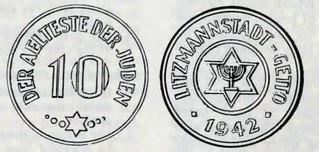 A Newman Portal user searched this week for “Terlecki.” No matter how smart you think you are, looking at a few recent searches will never fail to humble you – it’s all numismatic, and it’s
all words and terms and stories you have never heard of before. A search on Terlecki reveals, from The Shekel (1968, no. 4), that Terlecki catalogued the siege coins of the Lodz ghetto during
WWII.
A Newman Portal user searched this week for “Terlecki.” No matter how smart you think you are, looking at a few recent searches will never fail to humble you – it’s all numismatic, and it’s
all words and terms and stories you have never heard of before. A search on Terlecki reveals, from The Shekel (1968, no. 4), that Terlecki catalogued the siege coins of the Lodz ghetto during
WWII.
From Frank and Laurese Katen’s numismatic literature auction catalog of August 1970 (lot 2064), we learn that Terlecki in 1965 wrote a general guide on Polish coins, Illustrowany Katalog Monet Polskich, covering the period 1916-1965.
Remy Bourne’s literature sale of September 1995 gives the full name, Wladyslaw Terlecki, and at this point we move over to Wikipedia, where a short biography of Terlecki (1904-1967) can be found. Per Wikipedia, Terlecki pulled gold and platinum bars from the Polish State Mint and buried the material to save it from Nazi confiscation. Wikipedia should not be relied on as a final authority, but it does cite an original document which likely contains further information of interest to a researcher of Polish numismatics.
Link to The Shekel (vol. 1, no, 4, 1968) on Newman Portal:
https://nnp.wustl.edu/library/book/515001?page=26
Link to Katen’s August 1970 auction sale catalog:
https://nnp.wustl.edu/library/auctionlots?AucCoId=511068&AuctionId=517336&page=71
Link to Remy Bourne’s September 1995 auction sale catalog:
https://nnp.wustl.edu/library/auctionlots?AucCoId=510371&AuctionId=513009&page=39
Link to (translated) Wikipedia entry on Terlecki:
https://translate.google.com/translate?
hl=en&sl=pl&u=https://pl.wikipedia.org/wiki/W%25C5%2582adys%25C5%2582aw_
Terlecki_(in%25C5%25BCynier)&prev=search
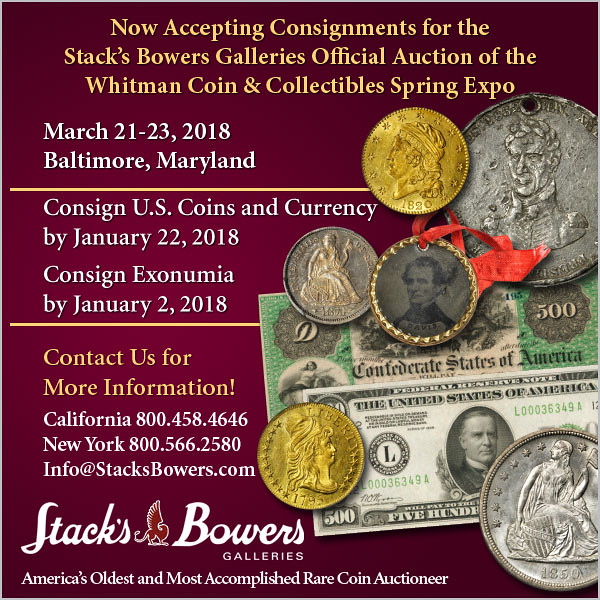
ARTICLE HIGHLIGHTS NATIONAL NUMISMATIC COLLECTION
Whenever we tell friends and family where we work, their first response is typically, "What is Numismatics?" Of course, they pronounce it anywhere from "numismatic" to "gnomimatic!" The National Numismatic Collection (NNC) is the Smithsonian's collection of monetary and transactional objects. It houses approximately 1.6 million objects spanning thousands of years and a great variety of materials. One of the best parts of our jobs is getting to share the collection with the world!
Numismatics is a far-reaching field, and we've found connections to military history, facial hair, woman suffrage, and even Game of Thrones! We often share things about our favorite objects, but here are a few large, notable collections that you may not know are housed within the NNC. We’re making these available online, and researchers are welcome to contact us regarding their research in these areas.
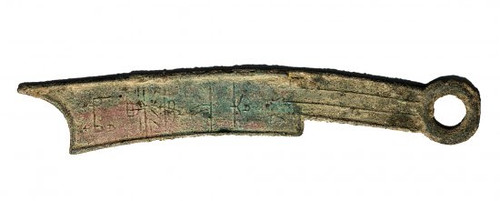
Chinese knife money
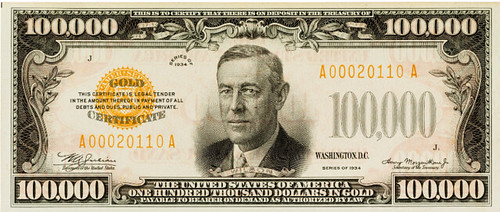
1934 $100,000 note
To read the complete article, see:
Numismanic, Nomismatic, Numismatics? (http://americanhistory.si.edu/blog/numismanic-numismatics)
To read the complete article, see:
Call a spade a spade (or a coin) (http://americanhistory.si.edu/blog/call-spade-spade-or-coin)
HOWARD F. BOWKER EAST ASIA NUMISMATIC COLLECTION
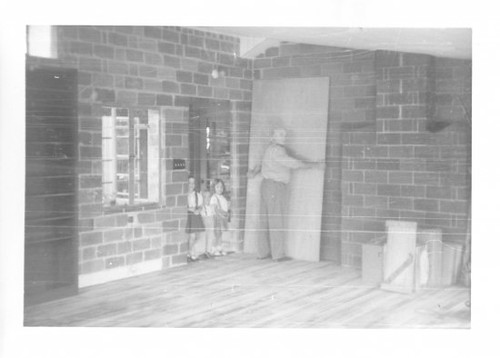
Imagine a 1,000-square-foot room holding thousands of tiny records of the past. You would probably assume such a room was part of a museum or library. But American collector Howard F. Bowker built a room like this in his California home. He filled it with more than 10,000 historic East Asian coins, banknotes, and stamps, as well as an extensive library that helped him study and interpret his large numismatic and philatelic collections. Earlier this year, Bowker's family donated a portion of his holdings to our National Numismatic Collection. This donation presents an ideal opportunity to explore what numismatic objects can reveal about the historic trade and technological connections between the United States and East Asia.
Bowker's passion for collecting and documenting East Asian history, culture, and art started when he was stationed as a U.S. naval officer in Hànkou, Hubei Province, China, following the conclusion of World War I. His extensive personal archive shows that he developed a sustained commitment not only to collecting, but also to conducting new research on the economic and social history of the region and sharing it with an international network of scholars and collectors.
Bowker's private collection ranged from some of the earliest Chinese media of exchange, including spades, bridge money, and knife money from the 5th century BCE to an impressive variety of both common and rare medieval, early modern, and modern Chinese, Korean, Japanese, and Filipino coins. Together, these objects present great research potential to both ancient and modern historians, anthropologists, and archaeologists who examine modes and patterns of exchange, circulation, cultural interaction and representation, coin production methods, and metallurgy.
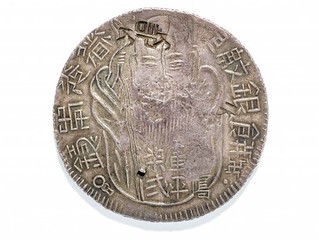 What is so exciting about Bowker's collection is that it not only documents the development of economic and cultural exchange in East Asia, but also contains objects that show how coins
and minting technology helped cultivate connections between the U.S. and Asia. In the late 19th and early 20th centuries, China sought to set up provincial mints and produce struck coinage en masse,
but it did not have the technical capabilities to manufacture the necessary minting equipment. Representatives of private overseas firms, including American firms, traveled to China and worked with
Chinese officials to design, manufacture, and export minting equipment for multiple Chinese mints.
What is so exciting about Bowker's collection is that it not only documents the development of economic and cultural exchange in East Asia, but also contains objects that show how coins
and minting technology helped cultivate connections between the U.S. and Asia. In the late 19th and early 20th centuries, China sought to set up provincial mints and produce struck coinage en masse,
but it did not have the technical capabilities to manufacture the necessary minting equipment. Representatives of private overseas firms, including American firms, traveled to China and worked with
Chinese officials to design, manufacture, and export minting equipment for multiple Chinese mints.
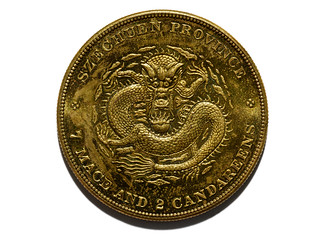 Americans even engraved designs for some of China's most iconic modern coins from that period. For example, the Ferracute Machine Company of Bridgeton, New Jersey, worked with U.S. Mint
Chief Engraver Charles Barber to produce brass gilt proof pattern coins for the Sìchuan province around 1902. These coins feature a commanding dragon design and have both English and Chinese
characters. A set of these coins were held in the Ferracute Company archive for half a century before they were given to Howard F. Bowker by the president of the Ferracute Company as a gift in the
1950s.
Americans even engraved designs for some of China's most iconic modern coins from that period. For example, the Ferracute Machine Company of Bridgeton, New Jersey, worked with U.S. Mint
Chief Engraver Charles Barber to produce brass gilt proof pattern coins for the Sìchuan province around 1902. These coins feature a commanding dragon design and have both English and Chinese
characters. A set of these coins were held in the Ferracute Company archive for half a century before they were given to Howard F. Bowker by the president of the Ferracute Company as a gift in the
1950s.
The brass gilt Sìchuan coins are among the more than 380 Bowker Collection objects that the Howard F. Bowker family has donated to the National Numismatic Collection. These new acquisitions, as well as all of the National Numismatic Collection's East Asian coins (more than 10,000 in total), will soon be digitized and available for study online and for consultation in the National Numismatic Collection's new Howard F. Bowker Research Room. A selection of these objects are also on display in the New Acquisitions case within The Value of Money. We hope that by making these objects available to researchers and museum visitors, they will serve as an international resource for the study of East Asian and U.S. history—as well as a reminder of the power of numismatic objects to connect people and their cultures across space and time.
To read the complete article, see:
Exploring connections between the U.S. and East Asia through the Howard F. Bowker Numismatic Collection
(http://americanhistory.si.edu/blog/east-asia-bowker-collection)
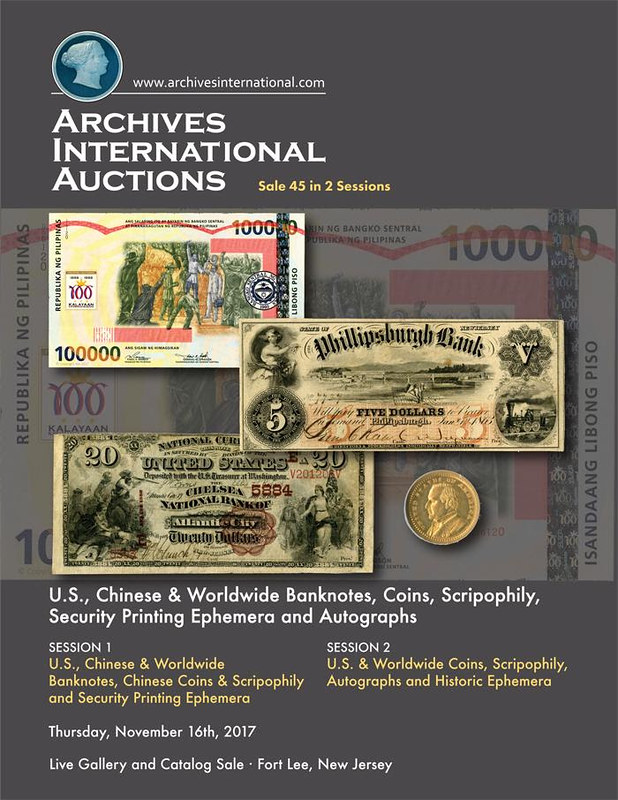
NOTES FROM E-SYLUM READERS: NOVEMBER 12, 2017
Notes From Q. David Bowers
Dave Bowers writes: Regarding last week's E-Sylum,
Nice issue! Comments:
Any and all scans of numismatic catalogs and books should be at a minimum of 400 dpi, or else they are useless for reproduction. When an original copy is at hand it makes sense to do a high-resolution image. Otherwise we have a modern-day iteration of Recordak microfilm—fuzzy images.
Second, the finding of an old coin does not mean it was placed there in the era the coin was minted. Some years ago there was excitement on the West Coast when an old coin was found, leading to the speculation that Francis Drake had landed there. If some long-ago collector dropped a stray English hammered coin from, say, 1300, in New Hampshire, this does not prove that the English settled here before the Vikings, etc.
To read the earlier E-Sylum issue, see:
http://www.coinbooks.org/v20/club_nbs_esylum_v20n45.html
Query: U.S. Mint Numismatic Library
Pete Smith writes:
I've gotten a little behind in my reading!
There was an article in the March 31, 1971, issue of Coin World with the title, "U. S. Bureau of Mint Establishing Numismatic Library In Washington.".Mint Director Mary Brooks announced that the Bureau of the Mint was establishing a numismatic library to serve numismatic writers, researchers and collectors.
I don't recall anyone reporting of a visit to this library and what research value might be there. Does this library include Henry Voight's missing account book?
Can any E-Sylum reader report on a visit to this library?
George writes:
I do not recall reading the article or knowing about the announcement. Certainly, I would have put the Mint on my mailing list!
I do wonder if Brooks knew that what appears to have been the heart of the Mint Library, “814 numismatic books,” was transferred to the Smithsonian Institution in late 1924 or early 1925 (see page 11, Vladimir Clain-Stefanelli, “History of the National Numismatic Collections,” 1968). In the mid-90s I spent a few minutes among the stacks at the Smithsonian’s numismatic library and seem to remember seeing a few titles originally in the Mint Library.
Roger writes:
If one exists, Mary Brooks took it with her to the grave. There is an internal-use library that has been a long-established entity at Philadelphia, but I am not aware of any Mint documents. It contains reference books and journals that the Mint subscribed to.
Foreign Coins Circulating in Britain
David Pickup writes:
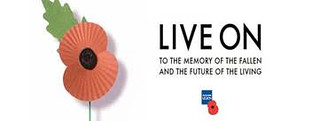 In the UK we wear poppies to raise money for the Royal British Legion which supports veterans and their families. I have started counting money in my community and so far have found,
In the UK we wear poppies to raise money for the Royal British Legion which supports veterans and their families. I have started counting money in my community and so far have found,
A Mauritian rupee, 12 euros, one US dime, 5 cents Canadian, Taiwan 10?, 1 States of Jersey pound note, 2 Swedish kronor, Burundi 5 sen, a Shakespeare histories £2.00, a number of interesting 50ps including Issac Newton, Hastings and Beatrice Potter and a shirt button!
ANOTHER WASHINGTON BEFORE BOSTON MEDAL PLASTER
I was taken back a bit when I saw the discussion in this week's E-Sylum about the plaster of the rejected obverse die for the Washington Before Boston Medal for a couple of reasons. First, I have one. I am enclosing a couple of pictures. I don't have a caliper, but it looks like it's about 66 mm across.
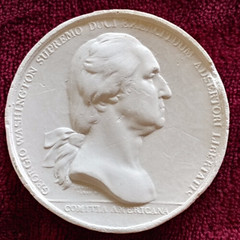
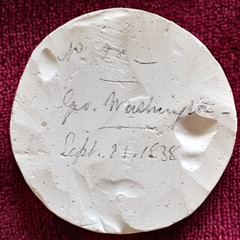
I bought it on eBay in July, 1999 for $50. I have been aware that it was the rejected obverse, and have puzzled over how it could have been made since the only known pieces are the shells. It was not included in the sale of my Washingtonia by Joe Levine in May, 2011 (Presidential Coin and Antique's Auction 81). That auction did include my shell of the rejected obverse die (B 47X, lot 141). I actually had bought my shell on eBay as well. When I saw the shell listed in February, 2006 I immediately recognized it for what it was. I was the only bidder and bought it for a winning bid of $5, plus another $5.85 for shipping! It sold for $2350 in Joe's auction. I don't recall if I had mentioned the plaster piece to Joe or not, to be honest.
The back of my plaster is also interesting. It has written in pencil "No. 98 geo. Washington. Sept. 21, 1838" Does this provide a clue? Also, the one in the E-Sylum does not appear to have "Du Vivier Paris" under the bust, while mine does (although it might just be the picture...).
The other reason I was surprised to see the discussion about the plaster piece was that last month, while on a trip to New Hampshire, my wife and I visited the Saint-Gaudens National Historic Site, where we saw his plaster maquettes of the $20 gold pieces and other medals. At the time, it reminded me of my plaster of the rejected Washington Before Boston obverse, which I really had forgotten about.
Also, for what its worth, mine came with a small wooden base. It is not attached to the base in any manner.
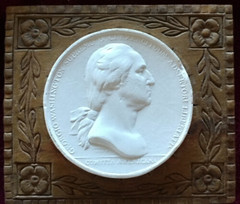

Anne Bentley adds:
I could be wrong, but I would guess that the carved base was something commissioned at some point by an owner. Somehow it doesn’t seem like it would have been an official mint production.
David responds:
Perhaps it was part of a collection of plaster reproductions and the wooden base was used as a way to display them. That might also explain the number on the back. But that still begs the question of how it could have been made, given that the rejected obverse is only known in the extremely rare uniface shells, and no known medals were struck...
Lead filled shell obverse with a beaded border
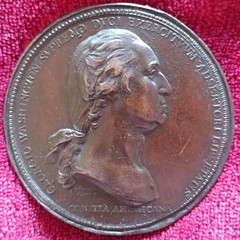 BTW, I still have another odd item that Joe did not include in the auction. It's a lead filled shell of the obverse of the Washington Before Boston Medal, but with a beaded border.
I'm enclosing a picture. As you can see, it has the diagnostics of the original die. Joe sent it to George Fuld and Dick Johnson to look at, and apparently Mr. Adams also saw it. Here's what
Joe told me in 2011.
BTW, I still have another odd item that Joe did not include in the auction. It's a lead filled shell of the obverse of the Washington Before Boston Medal, but with a beaded border.
I'm enclosing a picture. As you can see, it has the diagnostics of the original die. Joe sent it to George Fuld and Dick Johnson to look at, and apparently Mr. Adams also saw it. Here's what
Joe told me in 2011.
" 'George Fuld said: 'John Adams thinks this is possibly an official development piece but more likely a private attempt to improve the medal. I agree.'
Dick Johnson said he believed it to be a 'home made cast' and was 'worthless' ".
I bought the beaded border piece from Chuck Kirtley in March, 1993. It had originally been scheduled as a lot in a floor sale at a hotel in New York, but this hotel was impacted by the 1993 World Trade Center bombing and the sale was cancelled, so Chuck included it as a lot in one of his mail bid/phone sales.
I also have notes from my visits to the Long Beach Coin Shows in June and October, 1995. In June I took this piece to show around. My notes say “Alan Weinberg and Jack Collins got excited— thought might be ‘pattern’. Weinberg wanted to buy it—Tony Terranova thought it might be ‘contemporary cast’ used on things like boxes as decorative item.”
My notes from the October 1995 show say that Jack Collins “spoke a lot about it…and what an intriguing piece it is” Also that he had “Told Steve Tannenbaum it may be a pattern.” My notes conclude by saying that Jack “…went on a lot about it, also that Alan Weinberg spoke a lot about it and that Jack even asked if Weinberg had pestered me to buy it…”
Looking forward to hearing any thoughts about yet another rejected obverse plaster, as well as the beaded border piece.
Fun stuff...
To read the earlier E-Sylum article, see:
QUERY: WASHINGTON BEFORE BOSTON MEDAL PLASTER (http://www.coinbooks.org/v20/esylum_v20n45a17.html)
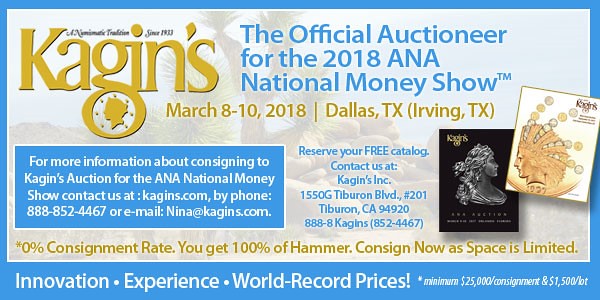
ELISHA KENT KANE MEDAL VARIETIES
When I first began this collection in 2004, and now this catalog, I had no idea how much material there was or that much of it was simply not listed anywhere. And I am still 'discovering' new items. On this page I will list any items I obtain for my collection or images that are sent to me by others of pieces that are new to me. I call this "New Discoveries" although they may be items known to others that I was not aware of. This could include a variety I had not seen before, a piece struck in a metal not listed in a catalog, or something I simply did not know existed. I will keep these posted on this page for 6 months as well as posting on the proper page on the website.
A series of on-line searches sparked by a recent email from Jonathan Brecher has led to some interesting finds of medals related to the Elisha Kent Kane Medal pictured below.
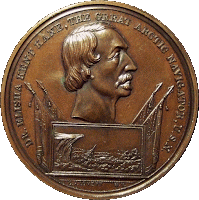
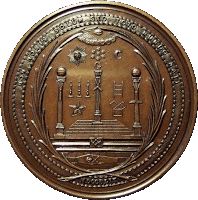
Although Q. David Bowers describes this work in his book on Sage, "American Numismatics Before the Civil War", Sage is not mentioned on the medal and he may have not been the exclusive distributor for these. He also mentions the obverse being combined with two other dies by George H. Lovett, The Great Medal of Honor and what I call the Three Muses. Below is a medal using these two dies.
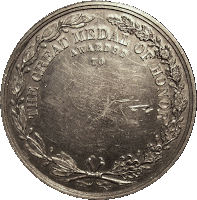
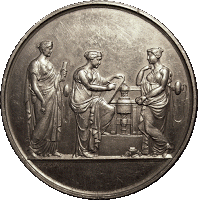
Now here is where it gets interesting. The following image is from the Tulane University Digital Library (https://digitallibrary.tulane.edu/islandora/object/tulane%3A50462)
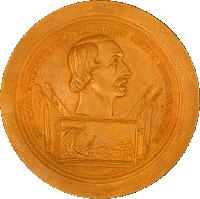

(image from Stacks Archives)
This reverse appears to be the reverse from an Arctic Exploration medal by Tiffany
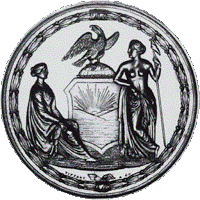
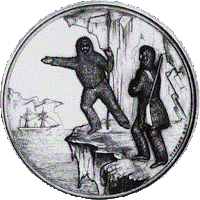
This medal is listed as 59.7mm in size, the Kane medal is 50mm but notice what appears to be wide rims on the Kane die. I cannot determine from the Tulane image whether the Tiffany & Co. has been removed. And it gets even more interesting with the following medal from the March 2017 Stacks Sale.
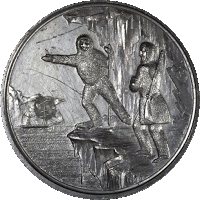
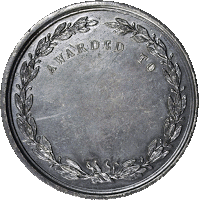
This one is described as 60.2mm with the Tiffany & Co. removed. And the reverse die is George H. Lovett's reverse die for an American Institute medal, Harkness NY-100 at 60mm! Are we to assume George H. obtained a Tiffany die, or did someone else obtain these dies to strike these mulings? If anyone has any information on these please contact me.
To read the complete article, see:
Lovett Tokens & Medals : New Discoveries : Elisha Kent Kane varities
(http://lovetttokensmedals.blogspot.com/p/whats-new-on-site.html)
VOCABULARY TERM: HOT SHORTNESS
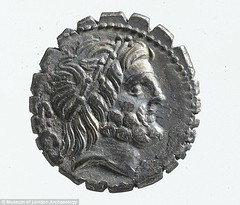
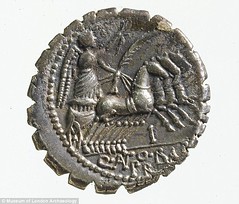
What caused those notches around the edge of this coin? What’s the term for these? They are not clipped or cut out. It is from striking a heated blank of impure metal, particularly with high lead content. This is an extreme example. Normally such coins exhibit small multiple fissures.
Hot Shortness. Cracks or notches around edges of cast blanks (or cast objects) caused by different melting points of impurities. Ancient coins often display evidence
of such hot shortness – they were often made of impure metal and the blanks were heated before striking. Low melting point metals, such as lead, were squeezed out during striking leaving the fissures
around the edge.
CLASS 07.9
Looking for the meaning of a numismatic word, or the description of a term? Try the Newman Numismatic Portal's Numismatic Dictionary at: https://nnp.wustl.edu/library/dictionary
MARQUIS DELAFAYETTE STOPHLET (1846-1920)
Marquis DeLafayette Stophlet (1846-1920), was born August 18, 1846 at Holmes County, Ohio... Marquis was a Civil War Veteran, who was mechanically inclined and became a carriage maker, machinist, mechanic, and plumber. He was a coin collector.
In August 1862 he enlisted in the Army in Company D, 120th Ohio Volunteer Infantry. He fought in the Battle of Chickasaw Bayou, Mississippi in 1862. In 1863, he fought in the Arkansas Battles of Arkansas Post, Port Gibson, Mississippi Battles -Big Black River, Siege of Vicksburg, Battle of Jackson. He was captured when City Belle sank in 1864 and he along with many soldiers were held prisoner at Camp Ford near Tyler, Texas.
After the Civil War he returned to the family farm at Holmes County, Ohio.
On August 10, 1873 he married Elizabeth Heller (1853-1929), in Wayne County, Ohio. They had no issue.
About 1875 he began his own shop as a carriage maker.
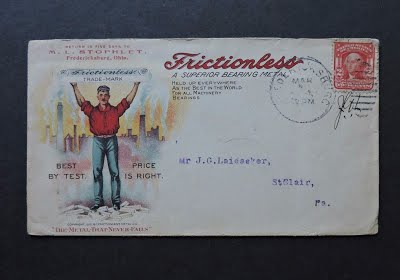
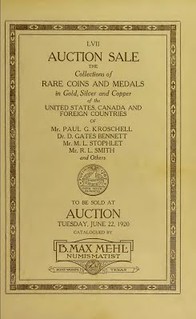 About 1885 he expanded his shop into a machinist shop. By 1901 he was a distributor for the Frictionless Metal Company manufacturers of a metal of high tensility ideal for weight and high
pressure bearing.
About 1885 he expanded his shop into a machinist shop. By 1901 he was a distributor for the Frictionless Metal Company manufacturers of a metal of high tensility ideal for weight and high
pressure bearing.
His coin collection was sold one month prior to his demise on June 22, 1920 by B. Max Mehl.
He died on July 21, 1920 at Holmes County, Ohio.
To read the complete article, see:
STOPHLET, MARQUIS DELAFAYETTE (https://sites.google.com/a/numismaticmall.com/
www/numismaticmall-com/stophlet-marquis-delafayette)
The entire inventory of the Lupia Numismatic Library is for sale. Individual items will be available before the remaining archives are broken up into parcels sold at philatelic auctions in the U. S. and Hong Kong. Check NumismaticMall.com frequently as dozens of new items with estimates will be posted daily until everything is sold.
All inquiries will be given prompt and courteous attention. Write to: john@numismaticmall.com .
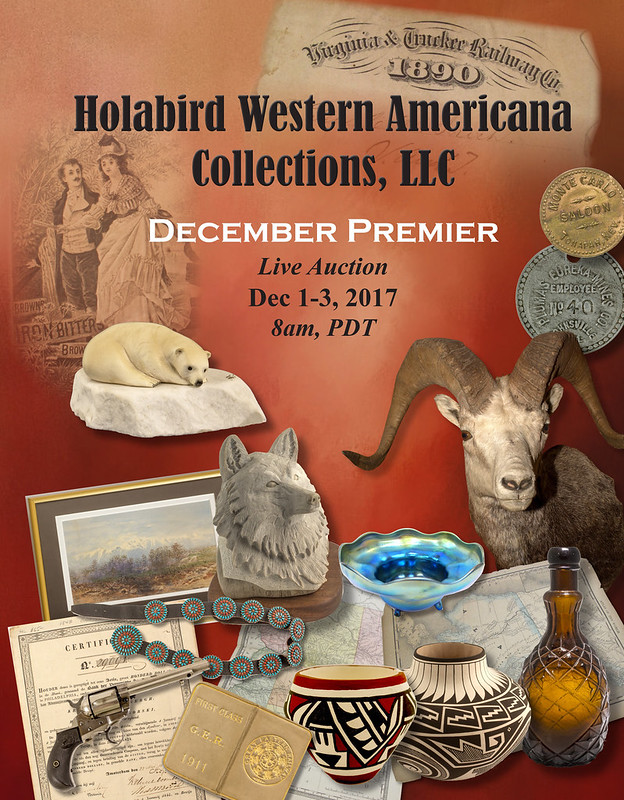
CRAIG SHOLLEY ON THE CONTINENTAL DOLLARS
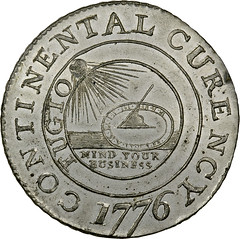 I have been following with great interest the controversy concerning the Continental dollars and have discussed at some length with my good friend Rob Rodriguez, so my commentary will come
as no surprise.
I have been following with great interest the controversy concerning the Continental dollars and have discussed at some length with my good friend Rob Rodriguez, so my commentary will come
as no surprise.
The issue I have with the proponents that these are a U.S. issue is they have yet to address the 600 lb. gorilla in the room: there is NO contemporary American documentation stating that these pieces were struck in the U.S. The U.S. documentation that does exist, the Pennsylvania Gazette and the New York Journal notices of 1776, merely note the proposal to strike coinage, not an actual striking, and make no mention of dollars or pewter. The Gazette notice is particularly weak as it states "We hear it is proposed..." Thus, it is nothing more than a RUMOR OF A PROPOSAL.
The London accounts are the only ones that say that a mint was established by Congress and coins were struck. We'll ignore the fact that this may well be nothing more than a story getting distorted over time and distance and get to the salient point. If the one wishes to convince me that the London accounts are correct, then show me documentation of where the mint was and that dollars were struck (any composition) or show me the authorizing legislation. Without contemporary American documentation, preferably from a Philadelphia source, then all the proponents have is some very shaky circumstantial tales, with "circumstantial" probably being too strong a word to describe these stories.
It is an axiom that the proponents of a theory must provide firm proof of the theorem or it must be considered void, however the proponents of the "U.S. struck" theory have consistently failed to do so. In fact, it is actually those arguing against that have provided contemporary American documentation that they WERE NOT struck in the U.S. in the form of Du Simitiere's statement. This statement is further corroborated by Dryander.
Regardless of whether one wishes to believe these statements or not, the simple fact is that both of these gentlemen were in a position to have knowledge of the subject and thus their statements cannot be dismissed out-of-hand. It is now up to the proponents to provide equally strong contemporary assertions that the pieces were struck in the U.S. or their theorem is then twice voided and well on it's way to becoming a numismatic black hole.
"Interpreting" bits and pieces of stories and attempting to stitch them into support will not serve. The time for the proponents to provide solid, direct, substantive documentation is long past due. Like the current generation is so fond of saying, "Video, or it didn't happen."
I spoke with Craig and Rob in person at this week's Whitman Baltimore Coin Expo. See my Numismatic Diary elsewhere in this issue for more on the topic from Rob and Tony Terranova. -Editor
Correction
Rob Rodriguez writes:
I would like to add clarification to the exhibit I provided for last week’s issue. After publication, I sent the exhibit identifying the 2-C Continental Dollar to my colleague Maureen Levine. She responded that she and Eric Newman had done the same thing in their Numismatist article, “18th-Century Writings on the Continental Currency Dollar Coin,” on pages 43 and 44. I did not recall their doing this; thus, I can honestly say that I corroborated their identification.
To read the earlier E-Sylum articles, see:
ROB RODRIGUEZ ON THE CONTINENTAL DOLLARS (http://www.coinbooks.org/v20/esylum_v20n44a13.html)
ONGOING THOUGHTS ON THE CONTINENTAL DOLLAR (http://www.coinbooks.org/v20/esylum_v20n43a12.html)
BEISTLE COMPANY ANNIVERSARY ITEMS


Beistle 50th Anniversary Medal

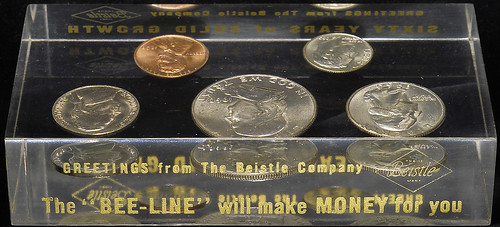
Beistle 60th Anniversary Paperweight
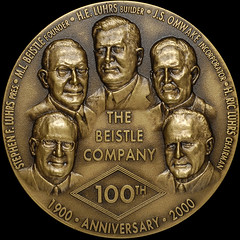

Beistle 100th Anniversary Medal
To read the earlier E-Sylum article, see:
M. L. BEISTLE'S COIN FOLDER PRODUCTS (http://www.coinbooks.org/v20/esylum_v20n45a16.html)
A NUMISMATIC SENTIMENT
Dave Lange writes:
I was examining some recent coin album purchases and found a greeting card tipped inside one. I thought it might be fun to share its sentiments with readers.
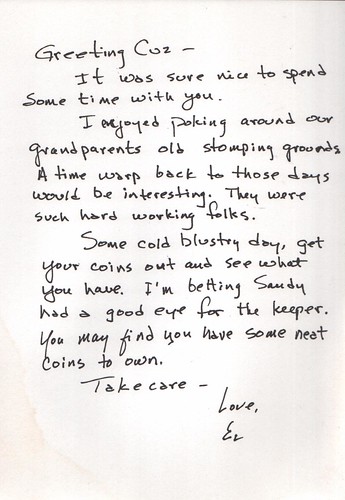
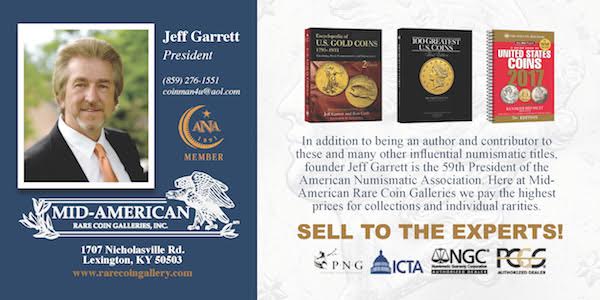
ARCHIVES INTERNATIONAL SALE 45
U.S., CHINESE AND WORLDWIDE BANKNOTES, COINS AND SCRIPOPHILY WILL BE OFFERED IN 2 SESSIONS AT PUBLIC AUCTION ON THURSDAY, NOVEMBER 16th, 2017
The auction will be held by Archives International Auctions, at their offices in Fort Lee, N.J.
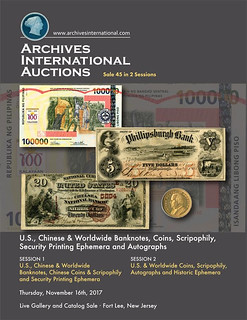 The November auction will feature an extensive collection of U.S., Chinese and worldwide banknote rarities as well as an impressive collection of California and State Fractional Gold Coins,
many in very high grade; U.S. and foreign coin selections from an old estate collection that have not been offered previously at auction and hundreds of additional banknotes, stocks, bonds, and
autographs.
The November auction will feature an extensive collection of U.S., Chinese and worldwide banknote rarities as well as an impressive collection of California and State Fractional Gold Coins,
many in very high grade; U.S. and foreign coin selections from an old estate collection that have not been offered previously at auction and hundreds of additional banknotes, stocks, bonds, and
autographs.
On behalf of the entire Archives International Auctions team, I would like to personally welcome you to our 45th auction we have held over the last ten years. We are excited to offer over 800 lots of rare and desirable U.S. & Worldwide Banknotes, Coins, and Scripophily.
Included in the sale are consignments from numerous estates and longtime collections with many items having never been offered previously at auction. The sale is broken into two sessions, the first includes U.S., Chinese and Worldwide Banknotes, Chinese Scripophily, and Coins and Security Printing Ephemera. The second session consists of U.S. & Worldwide Coins, Scripophily, Autographs, Historic Documents, and fiscal items.
The numerous highlights include over 120 lots of Chinese banknotes and coins; an outstanding collection of California and State Fractional gold with many high-grade pieces; an interesting assortment of U.S. and World coins and banknotes as well as our usual large selection of worldwide scripophily. We are also featuring for the first time an excellent autograph collection featuring many famous literary autographs as well as a Princess Diana signature among others.
The auction will feature hundreds of additional rare and desirable banknotes, coins, and scripophily in every price range, for the beginner to the advanced collector. Previews will be held at Archives International Auctions offices Tuesday, November 14 th , Wednesday, November 15 th and Thursday, November 16 th from 10 AM to 5 PM and by appointment. For an appointment call 201-944- 4800 or email info@archivesinternational.com .
The online catalog for the November 16 th sale is on Archives International Auctions’ website and can be viewed via the Archives International live bidding platform. It can also be viewed as a virtual catalog or downloadable .pdf on their website. To pre-register for live internet bidding, log on to the Archives International Auctions website, at www.ArchivesInternational.com. seeking consignments for our upcoming sales, so please contact us to discuss how you may participate in our future auctions. I would like to thank everyone who has participated in our previous sales and has helped make this auction series a resounding success. We are looking forward to another exciting auction and hope you enjoy our current offerings.
We are now working on our Winter 2017 and Spring 2018 auctions and are seeking quality consignments for future auctions or outright purchase including U.S. and worldwide banknotes, coins, stocks, bonds, stamps, postal history, historic ephemera, autographs. To sell or consign one piece or an entire collection, please call AIA at (201) 944-4800; or e-mail them at info@archivesinternational.com .
You may also write to Archives International Auctions, at 1580 Lemoine Ave., Suite #7, Fort Lee, NJ 07024 U.S.A. To learn more about Archives International Auctions and the auctions planned for November 16 th , log on to www.ArchivesInternational.com.
Lot 34: Canadian Bank of Commerce, 1917 $10
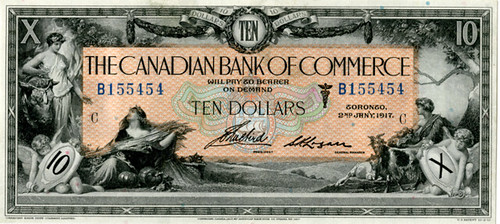
To read the complete lot description, see:
Canadian Bank of Commerce, 1917 $10 Issued Banknote.
(http://auction.archivesinternational.com/Canadian-Bank-of-Commerce-1917-10-Issued-Banknote_i28313326)
Lot 94: Kiangse Government Bank, 1907 Dollar Issue
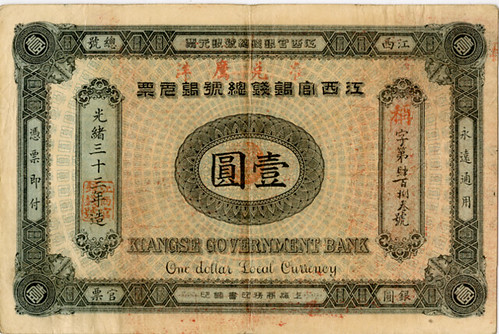
To read the complete lot description, see:
Kiangse Government Bank, 1907 Dollar Issue Banknote.
(http://auction.archivesinternational.com/Kiangse-Government-Bank-1907-Dollar-Issue-Banknote_i28313386)
Lot 102: Industrial Development Bank of Jehol, 1925
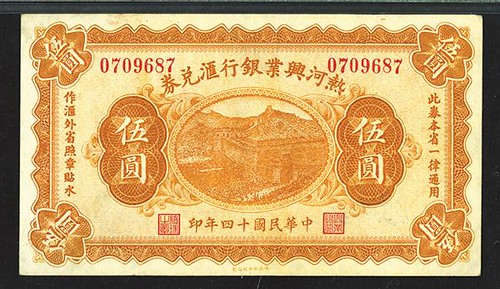
To read the complete lot description, see:
Industrial Development Bank of Jehol, 1925 Issued Banknote.
(http://auction.archivesinternational.com/Industrial-Development-Bank-of-Jehol-1925-Issued-Banknote_i28313394)
Lot 444: Phillipsburgh Bank 1863 $5
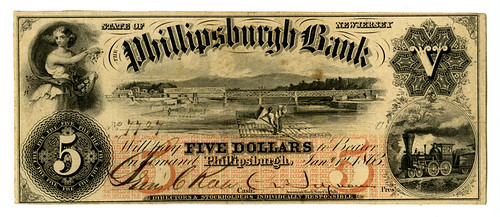
To read the complete lot description, see:
Philipsburgh, NJ. Phillipsburgh Bank 1863 $5 Obsolete Banknote.
(http://auction.archivesinternational.com/Philipsburgh-NJ-Phillipsburgh-Bank-1863-5-Obsolete-Banknote_i28313736)
Lot 445: Bank of the United States, 1840 $5000
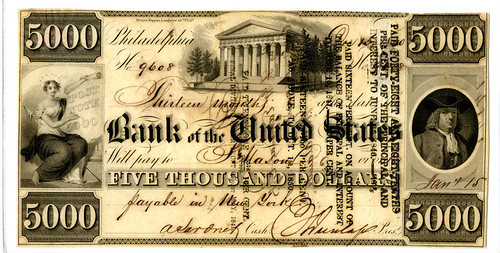
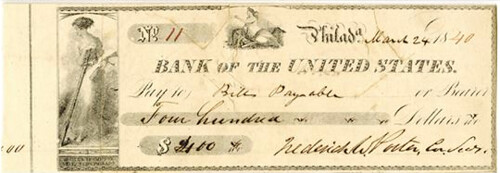
To read the complete lot description, see:
Bank of the United States, 1840, Issued Post Note & Check
(http://auction.archivesinternational.com/Bank-of-the-United-States-1840-Issued-Post-Note-Check_i28313737)
Lot 510: 1882 Chelsea National Bank of Atlantic City, $20
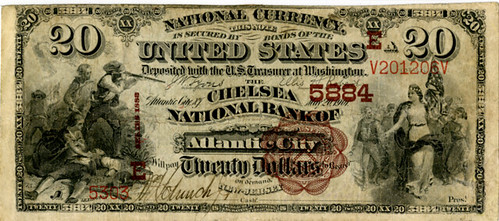
To read the complete lot description, see:
NJ. Chelsea National Bank of Atlantic City, $20 1882 Brown Back
Ch#5884 (http://auction.archivesinternational.com/NJ-Chelsea-National-Bank-of-Atlantic-City-20-1882-Brown-Back-Ch-5884_i28313802)
Lot 608: 1937 Lincoln Gold Token
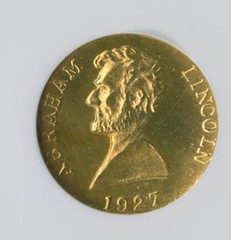
To read the complete lot description, see:
Lincoln 1927-Dated King-1043, Gold Token, Delorey-48,
T.Elder Issue, NGC graded MS64 (http://auction.archivesinternational.com/Lincoln-1927-Dated-King-1043-Gold-Token-Delorey-48-T-Elder-Issue-NGC-graded-MS64_i28313900)
Lot 632: Palestine Mandate Album, 1927-1946
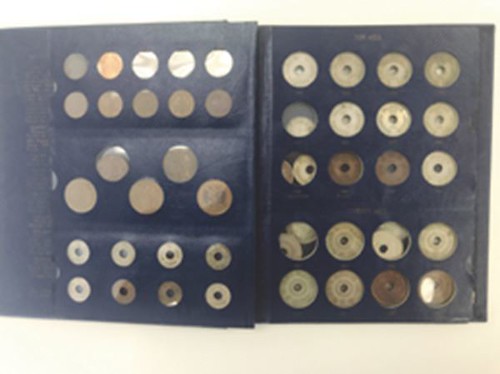
To read the complete lot description, see:
Palestine Mandate, 1927-1946, Group of 59 Coins in Album
(http://auction.archivesinternational.com/Palestine-Mandate-1927-1946-Group-of-59-Coins-in-Album_i28313924)
Alaska Gold "ONE Pinch" 1897 circular gold token,
Alaska-Yukon-Pacific Gold Token 25c, 1909, gold,
"Hart's Coin of the West"
California Fractional 25c 1866, BG-708, Octagon Liberty
gold
U.S. McKinley Commemorative $1 1903, gold
SEMINAR ON THE 15TH ANNIVERSARY OF THE EURO SYSTEM
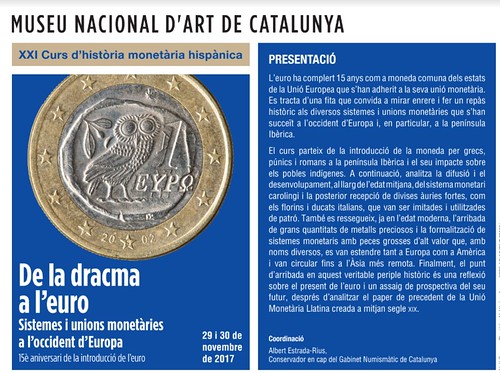
The curator of the numismatic cabinet at the National Museum of Art of Catalunya (MNAC), currently Dr. Albert Estrada Rius, presents a series of seminars (and subsequent publications of the lectures) every year, of which this will be the latest installment. I am a part-time volunteer for this numismatic cabinet, and strive to assist in their endeavors, providing English translations for the abstracts of the papers presented in the seminars.
AS EMISIONES GRIEGAS DE EMPORION Y RHODE Y SU IMPACTO EN LAS SOCIEDADES INDÍGENAS (The Greek emissions of Emporion and Rhode and their impact on the indigenous societies)
Marta Campo
INTRODUCCIÓN A LOS SISTEMAS MONETARIOS GRIEGO Y PÚNICO EN LA PENÍNSULA IBÉRICA: ALGUNOS EJEMPLOS (Introduction to the Greek and Punic monetary systems of the Iberian peninsula: Several
examples)
Bartolomé Mora
ROMANIZACIÓN Y MONETIZACIÓN EN HISPANIA. PRESENTE Y FUTURO DE LA CUESTIÓN (Romanization and monetization in Hispania: the present and future of the question)
Manuel Gozalbes
DAL FIORINO AL DUCATO: MONETE ITALIANE DAL MEDITERRANEO ALL’EUROPA (From the florin to the ducat: Italian coinage of the Mediterranean)
Lucia Travaini
DEL THALER AL REAL DE A OCHO: EL SISTEMA MONETARIO HISPÁNICO MODERNO (From the thaler to the piece-of-eight: the modern Hispanic monetary system)
José María de Francisco Olmos
LA UNIÓN MONETARIA LATINA Y EL SISTEMA MONETARIO DE LA PESETA (The Latin monetary union and the monetary system of the peseta)
Miguel Martorell Linares
EL EURO Y LA UNIÓN MONETARIA: HISTORIA Y PERSPECTIVAS DE FUTURO (The euro and the monetary union: history and future perspectives)
Agustin Ulied Martínez
DU DENIER DE CHARLEMAGNE AU GROS TOURNOIS: CRÉATION ET DIFFUSION D’UN MODÈLE MONÉTAIRE (From the Denier of Charlemagne to the gros tournois: creation and diffusion of a monetary model)
Dr. Bompaire
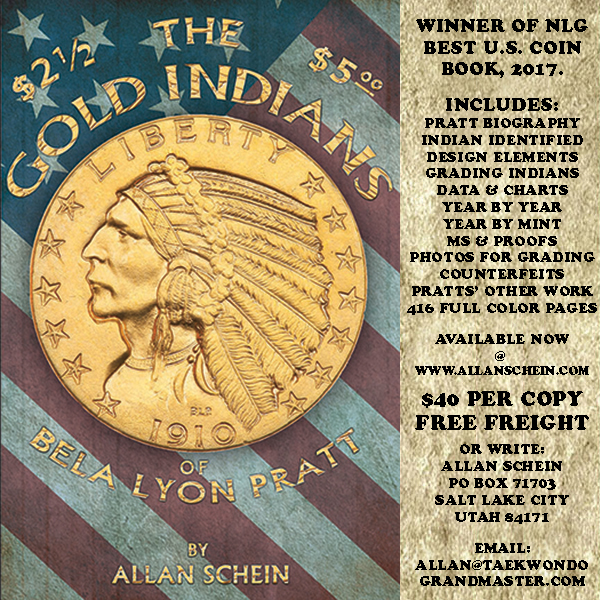
WAYNE'S NUMISMATIC DIARY: NOVEMBER 12, 2017
Pittsburgh Numismatic Archive Material
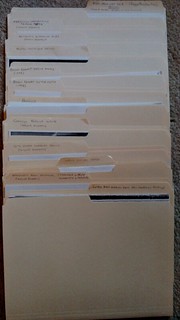 I found myself with a day off work Friday November 10, 2107 because of the Veteran's Day holiday on the 11th. As it happened, the fall Whitman Coin Expo was taking place at the
Baltimore Convention Center.
I found myself with a day off work Friday November 10, 2107 because of the Veteran's Day holiday on the 11th. As it happened, the fall Whitman Coin Expo was taking place at the
Baltimore Convention Center.
In the morning I packed my backpack with several files of interesting numismatic information I'd found while cleaning out a file cabinet in my home office last weekend. But first I typed up descriptions of the material to email to Newman Numismatic Portal Project Coordinator Len Augsburger. I would be giving him these to scan for NNP. Here are a couple descriptions readers should find of interest.
University of Pittsburgh Early American Room Coin Collection
The University of Pittsburgh's signature building is the Cathedral of Learning. A key feature of the Cathedral are the Nationality Rooms. Little known or used is the early American room. Tucked away on an upper floor, it is a recreation of an early settler's cabin. And little known to most numismatists, the room contains a display of early American coins donated by George H. Clapp.
This file contains notes and information written at different times by local numismatists Glenn A. Mooney and Wayne K. Homren.
For more information on Pitt's Nationality Rooms, see: http://www.nationalityrooms.pitt.edu/
1991 Carnegie Library of Pittsburgh Wadsworth Room Numismatic Literature Appraisal
When the Carnegie Museums of Pittsburgh deaccessioned the bulk of their coin collection in the late 1970s/early 80s, the collection's research library was transferred to the rare book department of the Carnegie Library. This file contains a 1991 appraisal for the library by local numismatic bibliophile Wayne Homren, with assistance from numismatic literature dealer John H. Burns.
Charles and Hubert
My northward drive was uneventful and I parked on an upper floor of the Sheraton hotel's garage next to the Baltimore convention center. At the registration area I ran into Charles Morgan and
Hubert Walker of CoinWeek, who showed me their brand new steadi-cam mount for their camera equipment.
Mark and Leif
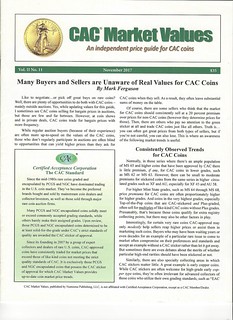 Among my visits was the table of Mark Ferguson, dealer and publisher of the CAC Market Values price guide. We discussed a collection he'd recently sold for the estate of an old
customer.
Among my visits was the table of Mark Ferguson, dealer and publisher of the CAC Market Values price guide. We discussed a collection he'd recently sold for the estate of an old
customer.
Mark also introduced my to his assistant, Leif Larson. Leif is an artist who has branched out into numismatic topics. He had one work with him for sale, and he kindly supplied this image. Nice work. For more information, Leif can be reached via his web site at http://www.leiflarson.com/

QDB and Steve Hayden
At the table of token dealer Steve Hayden I ran into Dave Bowers,who was effusive in his praise for my work on The E-Sylum, calling me a polymath. "Jack of all trades, Master of
none" is closer to how I feel, but I do have wide-ranging interests and tastes. I'd been hoping to snag Steve as a regular advertiser since I feel the material he handles is a great fit for
the interests of our readers. He does plan to submit an ad for his next auction sale.
Chip Howell
As I was finishing up with Dave and Steve along came Chip Howell, a member of my office coin club. He gave me a tube of dollar coins for Nummis Nova member Ron Abler - they'd discussed these when
Chip joined us for dinner a couple months ago.
Jim, Craig and Rob
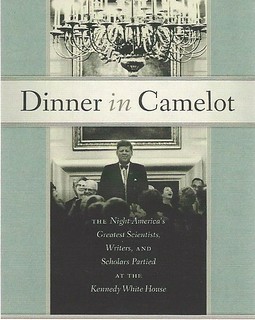 One of my next stops was Charlie Davis' table, where I ran into Jim Neiswinter. Jim showed me a nice Alan Grace binding of the ultrarare 1870 2nd edition Maris pamphlet on Varieties
of the Copper Issues of US Mint for the Year 1794. My Nummis Nova friend Joe Esposito came by and shared a card with the cover of his upcoming (non-numismatic) book, Dinner in Camelot.
Look for it in April!
One of my next stops was Charlie Davis' table, where I ran into Jim Neiswinter. Jim showed me a nice Alan Grace binding of the ultrarare 1870 2nd edition Maris pamphlet on Varieties
of the Copper Issues of US Mint for the Year 1794. My Nummis Nova friend Joe Esposito came by and shared a card with the cover of his upcoming (non-numismatic) book, Dinner in Camelot.
Look for it in April!
Seated at Charlie's table were Craig Sholley and his wife Bonnie. While speaking with Craig and Jim I saw Rob Rodriguez sidle up and bellow, "Hey, I'm looking for some A-hole named Wayne Homren - anybody seen him?" I pretended to look around and shrugged my shoulders. I told everyone how I would carry my daughter on my shoulders in department store and ask strangers, "Have you seen a little red-haired girl walking around here? I can't find her anywhere." Everyone would play along and get a lot of giggles out of her. She's thirteen now and heading to high school next year.
Craig had already emailed me a submission about the Continental Dollars in response to Rob's earlier article. An absolutely fascinating (and friendly) conversation ensued with Craig and Rob dissecting points of contention between them. Craig was still unconvinced of a 1776 U.S. origin, but acknowledged that Rob's elucidation provided a stronger argument in favor of that than had been presented earlier in The E-Sylum. I wish CoinWeek had been there to capture it with their video camera. Both agreed that actual evidence on the origins of the coins has not yet been found and agreed that they'd each be the first to publish any smoking gun evidence regardless of the side it supports. I'd had a front-row seat to first-class numismatic debate.
Tony Terranova
I think it was sometime before lunch when I stopped to see Tony Terranova. We talked about the Continental Dollar discussions in The E-Sylum. Tony has handled some 100 of the coins in his
years as a dealer and said quite a number of them show signs of circulation wear, and some were pretty heavily circulated. I noted that because highly circulated pieces are worth much less,
they're not the ones to appear often at major auctions. Tony encouraged researchers to look at PCGS CoinFacts and 3PG population reports to note the circulated examples.
Mike and Tom
Since I had to be back for a 2pm meeting with Jeff Garett I was unable to join the Maryland gang for their 1pm lunch. Unable to scare up lunchmates at the last minute I headed across the street to
the Pratt Street Ale House around 12:30, figuring I might just run into friends there anyway.
I was right, and pulled up a table next to my Nummis Nova buddy Mike Packard and Tom Gesner from Massachusetts. We had a great conversation over lunch with topics ranging from Mike and Tom's battles bidding against each other for the same coins, to Nummis Nova and the Spinx Society, how Mike got into collecting and researching Massachusetts coppers, and some of our best buys over the years. For me, these included an 1858 Constitution and Bylaws of the American Numismatic Society for $10, and an rare encased postage stamp for under $300 which I later sold for over $9000. BTW, Tom and I can recommend the crabcake sandwich. While paying the check I exchanged texts with Roger Siboni and learned he was at the C4 area looking at Mike's Massachusetts coppers!
David and Jack
After lunch I headed for the C4 table area to look for Roger, but accidentally walked past it. I ran into David Lisot of CoinTelevision and we chatted a bit about the show, the Newman Numismatic
Portal, and the videos he was making later in the day of talks at the show. He kindly pointed me in the right direction.
At the C4 table area (Hobo Village?) several collectors were milling about. I said hello to Will Nipper before being flagged down by Jack Howes. We discussed the Newman Portal's new image collection feature.
Robert Schwartz
Having missed Roger I went to Jeff Garrett's table next. He was running late from lunch so I caught up with longtime E-Sylum supporter Robert Schwartz of Archives International who'd
been talking with a potential consignor most of the morning. He'd just freed up and we discussed The E-Sylum and upcoming auctions. We continued our conversation while walking out to the
lobby area where Bob ordered lunch. It was a nice chat.
Jeff and Ian
On our way back in I saw Jeff at his table. I pointed at a nice Bechtler gold and kidded, "How much do you want for this $350 coin?" Jeff rattled off the price marked on the piece, about 20
times higher.
We discussed the ANA Edition of The E-Sylum, then Jeff walked me over to introduce me to Ian Russell of Great Collections. I sat down and we had a nice conversation, and made plans for ads in future E-Sylums.
Charlie Davis
Next I circled back to see numismatic literature dealer Charlie Davis as usual shared a table with Neil Musante. During both of my visits Neil was busy and I didn't get a chance to say hello. Hi,
Neil! Charlie was busy too, and this time I watched him sell a copy of Allan Schein's new book on the incuse gold Indian coins designed by Bela Lyon Pratt.
While Charlie and I chatted I snapped photos of some interesting books on his table.
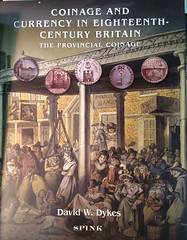
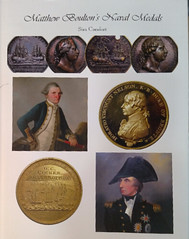
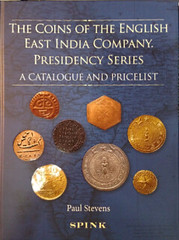
JK and Erik
At John Kraljevich's table I was unsurprised to see Erik Goldstein, the numismatic curator at Colonial Williamsburg. I have no idea how the conversation turned to body hair, but Erik noted his
general lack of it and said that JK on the other hand, "has had that beard since he was nine." That reminded me of a onetime sighting of a hairy man at the beach, whom I said "looked
like a monkey in a diaper." I left before the conversation could get around to numismatics, but there was plenty of that all day, as JK's table was swarmed by visitors every time I
passed.
Bonnie's Bracelet
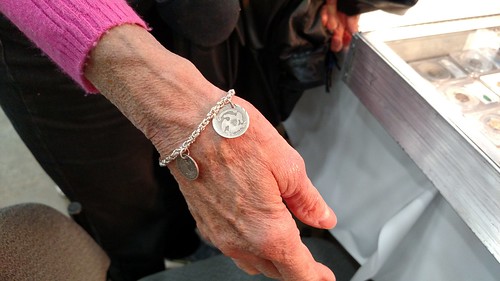
Somewhere along the way I visited Len Augsburger at E-Sylum supporter Gerry Fortin's table. Craig and Bonnie Sholley came by looking for Love Tokens. Gerry had none, but we all got a good look at Bonnie's love token bracelet, which is very timely because of the recent article on the topic by Carol Bastable.
To read the earlier E-Sylum article, see: LOVE TOKEN BRACELET PHOTOGRAPHIC HISTORY (http://www.coinbooks.org/v20/esylum_v20n44a14.html)
Ellen and Shanna
One of my last stops for the day was the table of E-Sylum supporter Shanna Schmidt. I greeted her boothmate "Shanna's Mom" and apologized for forgetting her name (it's
Ellen). Mary Lannin had introduced me to her at the last Baltimore show I attended. Conversation topics included their busy show schedule, Shanna's blog, Jeff Zarit and siege coins. I promised to
introduce Shanna to my friend Dr. Lawrence Korchnak. Larry is a collector of siege coins who is working on a manuscript for a book.
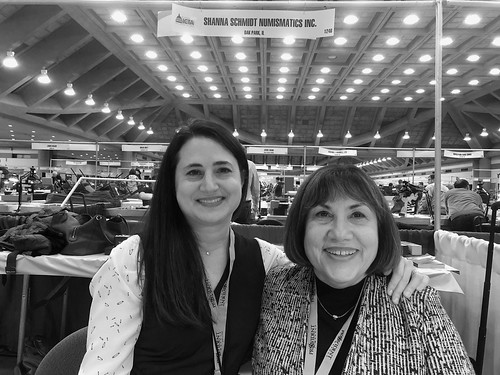
Shanna and Ellen, from Shanna's November 11, 2017 blog post
Looking at the time I realized that if I left right away I'd be able to make it home to Virginia in time to have dinner with my family. On the way out I met and spoke with Mary Burleson of Whitman and Brian Kendrella of Stack's Bowers about the show and their respective company's contributions to the Newman Numismatic Portal.
I pulled my jacket out of my backpack and put it on against the cold. I walked down the street to the Sheraton where I'd parked my car. Traffic was relatively light and I did indeed make it on time for dinner. It was a productive show and I'm looking forward to March already.
Here's a belated hello to some folks I saw from a distance and barely had a chance to wave to, including Wayne Herndon, Allan Schein, Julian Leidman, and Vicken Vegparian.
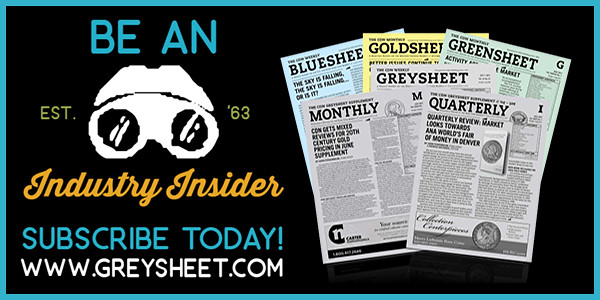
MORE ON THE SCOTNEY CASTLE COIN COLLECTION
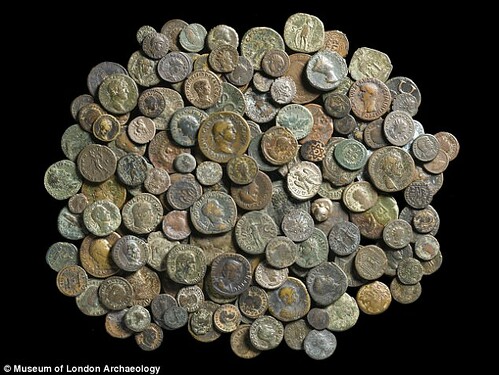
A collection of rare coins dating back 2,500 years have been uncovered in a study desk drawer at a 14th century castle in Kent.
The unique hoard of 186 coins that came from as far away as China and Syria was discovered by volunteers searching for photographs at Scotney Castle in Lamberhurst, near Tunbridge Wells.
The collection includes Greek coins from the seventh century BC and Roman coins from the late second century BC.
The collection is believed to have been amassed by Edward Hussey III and his son Edwy in the 19th century.
Nathalie Cohen, a National Trust archaeologist, said: 'We know that Edward and Edwy Hussey had a great interest in collecting, but this considerable cache of fascinating coins shows just how much their interest grew into a collection of exceptional importance.
'What is a mystery though is why a collection of this calibre ended up at the back of a drawer.'


The Husseys are thought to have gathered the trove between the 1820s and 1890s with an 1823 entry from Edward's diary showing prices of four to seven shillings and six pence paid for some coins. In one note from 1883 Edwy reveals he 'went to the British Museum with papa as he wanted to ask about some coins'. A National Trust spokesperson told MailOnline they have not sought to find the current value of the coins and say the collection will never be sold.
The majority of the collection features Roman coins from the late second century BC to the fourth century AD.
Experts from the Museum of London Archaeology (MOLA) believe 18 of the coins are rare examples.
Julian Bowsher, a MOLA coin specialist, said the find was 'significant and diverse'.
'A particular highlight was seeing Roman coins that rarely appear in Britain, such as those of the third century emperors Balbinus, Pupienus and Aemilian, none of whom ruled for more than a year,' he added.
A coin from the Greek island of Aegina is one of the earliest struck in Europe and features sea turtle, a creature sacred to Aphrodite.
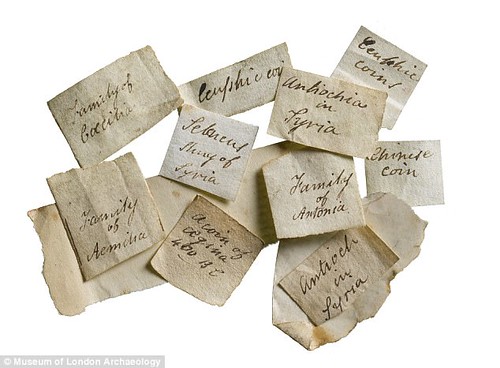
To read the complete article, see:
Collector's hoard of nearly 200 rare Roman and Greek coins dating back 2,500 years
is found in the back of dusty drawer at Scotney Castle (http://www.dailymail.co.uk/sciencetech/article-5054797/Hoard-ancient-coins-drawer-Scotney-Castle.html)
To read the earlier E-Sylum article, see:
OLD ROMAN COIN COLLECTION FOUND IN CASTLE (http://www.coinbooks.org/v20/esylum_v20n45a31.html)
BULGARIAN ROMAN COIN HOARD FOUND UNDER TREE
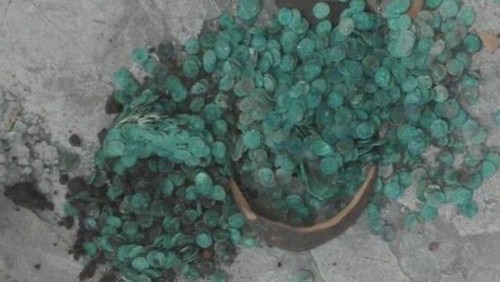
A coin hoard of Ancient Roman silver coins, which has been discovered by accident in the roots of a large tree in the town of Mezdra in Northwest Bulgaria, according to archaeologists, confirms the previously hypothesized existence of a Roman settlement – outside the already well known fortress “Kaleto" which was also used by the Romans. The treasure of Roman silver coins from the 1st-3rd century AD was discovered by accident during the uprooting of a 70-year-old wild plum tree in an abandoned yard in the town of Mezdra, Mezdra Municipality has announced.
The coin treasure was found in a ceramic jar underneath the roots of the tree which was compromised as the locals were using a pickax to extract them. It broke to pieces when one of them tried to remove it from beneath the roots.
However, the discovery of the Ancient Roman silver coin hoard, which occurred sometime in at the end of August 2017, was not reported immediately to the authorities.
A total of 183 coins were brought by some of the locals to the Vratsa Regional Museum of History some two weeks after the discovery, and Mezdra Municipality first announced the find in the middle of September. Four more coins were brought to the museum several days later.
The museum experts have been quick to state that in their view the broken pottery vessel had contained some 1,000 Roman coins at the time of its discovery, and Museum Director Georgi Ganetsovski has called upon the locals to return the missing some 800 coins.
Tsvetan Kotsev, the local man who tried to extract the ancient jar when it fragmented in his hands, told Nova TV that vessel weighed at least 4-5 kg.
A photo (see above) of the broken jar taken immediately after its extraction by the locals, and acquired by Mezdra Municipality, also seems to indicate that the ancient vessel contained a lot more coins.
The earliest of the coins that have made it to the Vratsa Museum denarii and antoniani from the reigns of Emperors Nero (r. 54 – 68 AD), Galba (68 – 69 AD), Vitellius (69 AD), and Vespasian (69-79 AD).
“The find includes 2nd century AD denarii of [usurper emperor] Clodius Albinus (193; 196 AD)," Ganetsovski says.
“[The end date of the coin collection] is marked by the last Emperor represented in it, Severus Alexander (r. 222 – 235 AD)," he adds.
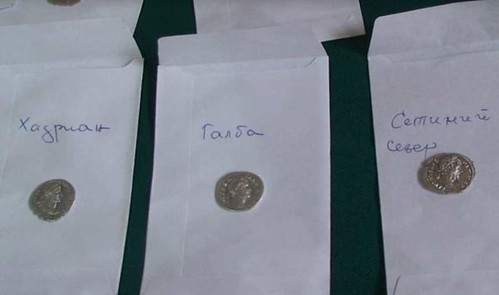
Coins of Roman Emperors Hadrian, Galba, and Septimius Severus
“[We have] established a very interesting sequence in the imperial emissions of the amassed coins as well as many coins dedicated to the emperors’ wives," the Museum Director notes.
“There are coins minted on the territory of today’s Syria which speaks of a very serious commercial circulation. The condition of many of the coins shows that they were in circulation. However, another part of them are well preserved, and apparently were not used at all but were collected," he elaborates.
To read the complete article, see:
ROMAN COIN HOARD FOUND BY CHANCE UNDER TREE ‘CONFIRMS’
EXISTENCE OF ROMAN TOWN IN BULGARIA’S MEZDRA (http://archaeologyinbulgaria.com/2017/11/10/roman-coin-hoard-found-chance-tree-confirms-existence-roman-town-bulgarias-mezdra/)

1863 $5 RICHMOND IN NATIONAL BANK NOTE SOLD
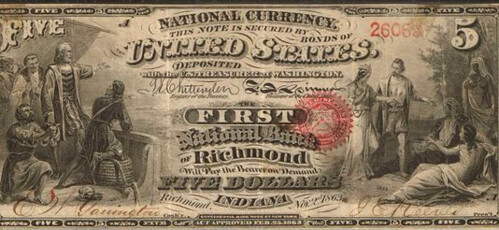
A Civil War-era piece of currency with ties to Wayne County sold at auction Thursday for a larger-than-expected amount.
The banknote, an 1863 $5 bill with the serial number 1, was bought during a live auction in Baltimore for $26,400. The identity of the new owner has not yet been made public.
The bill was printed on the East Coast, but was sent to the First National Bank of Richmond — one of the first chartered banks in the United States — where it was stamped Nov. 2, 1863.
The note was signed by bank president James E. Reeves, as well as the cashier, Thomas G. Yarrington, but was never released to the public.
Instead, it was likely kept as a souvenir by one of the men, said Manning Garrett, director of currency auctions for Stacks Bowers, the auction house which sold the piece.
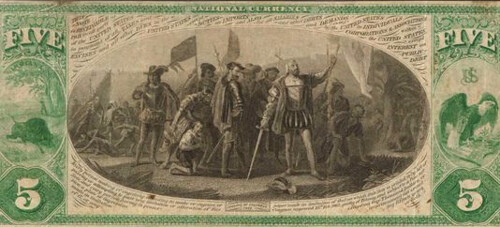
The 154-year-old piece of currency was discovered at an estate in Virginia, and was placed in the auction by a seller who did not want to be identified.
Garrett said prior to the auction the bill was expected to fetch anywhere from $15,000 to $25,000 at auction, but had the potential to sell for more.
The bill is believed to be the oldest piece of currency in Indiana's history that is still in existence. Another bill, from Fort Wayne, could be older, but it is believed to have been destroyed through wear and tear.
It is unknown whether anyone from Indiana took part in either the online bidding or the live election.
To read the complete articles, see:
This $5 piece of Richmond history could sell for thousands. Here's
why. (http://www.pal-item.com/story/news/local/2017/11/05/5-piece-richmond-history-could-sell-thousands-heres-why/814500001/)
Historic Richmond banknote sells for more than $26,000
(http://www.pal-item.com/story/news/local/2017/11/09/historic-richmond-banknote-sells-more-than-26-000/841419001/)
JANE AUSTEN NOTE ADVOCATE CAROLINE CRIADO-PEREZ
 The room, dominated by an enormous bed with a mattress at waist height to allow for storage underneath, has the feel of a cosy library with floor-to-ceiling bookcases and a half-moon desk
at the window. The literary ambience is apt given Criado-Perez is best known for her involvement with the Jane Austen campaign. But her achievement was never a crusade about the English novelist per
se. “It became reported as a campaign on Jane Austen,” she says. “It wasn’t.”
The room, dominated by an enormous bed with a mattress at waist height to allow for storage underneath, has the feel of a cosy library with floor-to-ceiling bookcases and a half-moon desk
at the window. The literary ambience is apt given Criado-Perez is best known for her involvement with the Jane Austen campaign. But her achievement was never a crusade about the English novelist per
se. “It became reported as a campaign on Jane Austen,” she says. “It wasn’t.”
Her involvement began when the Bank of England announced four years ago that Winston Churchill would replace Elizabeth Fry on the £5 note from 2016. That would mean there would be no women (apart from the queen) on notes issued by one of the world’s most influential central banks. “I didn’t care who the woman was. It was a matter of principle,” Criado-Perez says, explaining that she regarded the move as being a damaging example of women becoming less visible in society.
Having set up an online petition she worked with a solicitor to write to the Bank, calling it out for falling short of a duty as a public body to ensure equality. Meetings with Victoria Cleland, then director of notes, and Chris Salmon, then chief cashier, followed and in the end it was the Bank that suggested Jane Austen as a suitable candidate.
Born in Brazil to an Argentine father and British mother, she is bilingual in Spanish and English, and spent her childhood in Spain, Portugal, the Netherlands and Taiwan before moving to the UK as a teenager to attend boarding school. “It was a huge culture shock,” she says, recalling teenage concerns about fitting in. “The boy bands I knew were Taiwanese!”
The banknote campaign was a major victory, winning Criado-Perez plaudits, including an OBE for services to equality and diversity. But it carried a personal cost: she was subject to horrendous online abuse and two people were later jailed for making lurid threats against her.
To read the complete article, see:
‘Who expects death threats for asking for a woman on a banknote?’
(https://www.ft.com/content/1d250ebe-bf1b-11e7-b8a3-38a6e068f464)
THIEVES BLOW UP CASH MACHINE
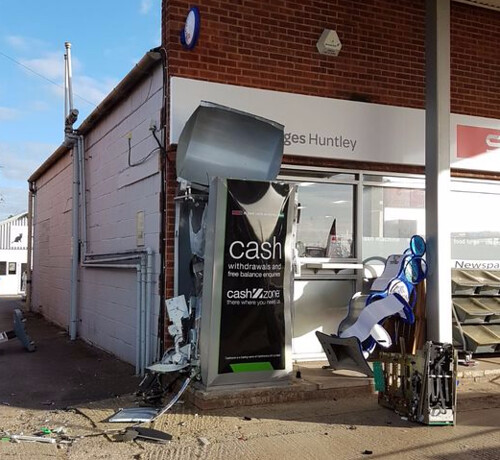
If you are offered a banknote that looks as if it has been heat damaged, it could be part of the loot from an explosive cash machine raid this morning.
Police are investigation the raid at an A40 petrol station in Gloucestershire that they believe could be part of a series of crimes.
It is believed that the cash machine had been blown from the wall of the Huntley garage with a gas cylinder and the bank notes stolen in the early hours of this morning.
Officers had been called at around 1.30am to the scene in Ross Road and some cash was found at the scene, including some new plastic notes which had been shrivelled by the heat.
To read the complete articles, see:
Explosive device may have been used as raiders target A40 petrol station
(http://www.gloucestershirelive.co.uk/news/gloucester-news/explosive-device-been-used-raiders-756255)
Hot money: Banknotes burned in explosive cash machine raid could be in circulation amid
fears raiders will strike again (http://www.gloucestershirelive.co.uk/news/gloucester-news/hot-money-banknotes-burned-explosive-756642)
To read an earlier E-Sylum article on the topic, see:
TRAIL OF BANKNOTES LEADS COPS TO CROOKS (http://www.coinbooks.org/esylum_v19n37a32.html)
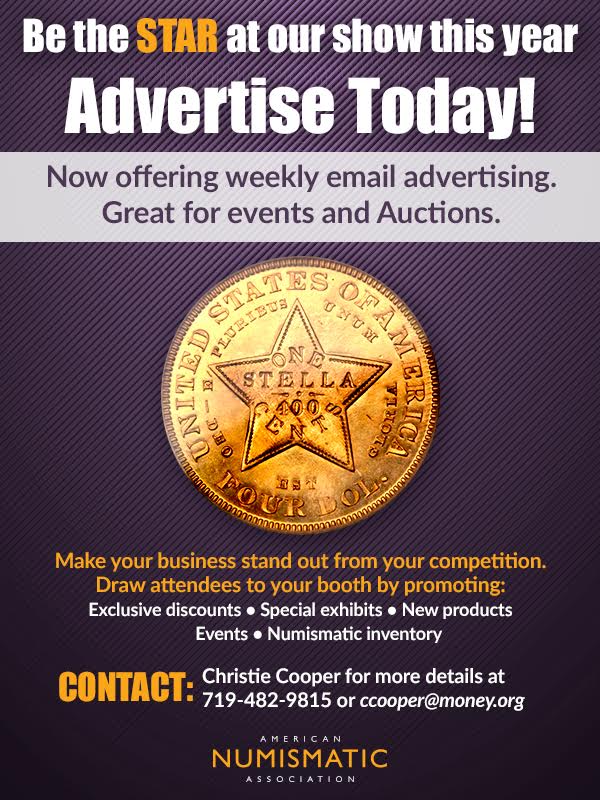
PAINTING OF 1880 $10 LEGAL TENDER NOTE OFFERED
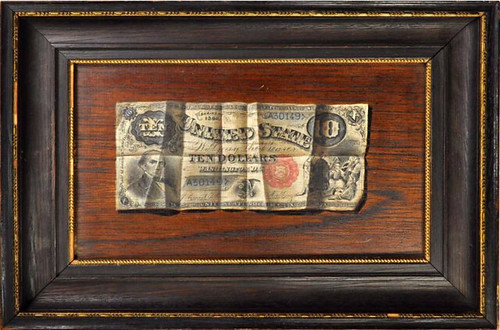
Ca. 1900 American Trompe l'Oeil Painting of 1880 $10 Legal Tender "Jackass" Note, Friedberg 111.
Unsigned. Oil on board, 10"x6", within contemporary 13"x9" outer wood frame. A wonderful example of this genre that was uniquely American when it started in the late 1870s--the realistic, deceptive depiction of paper money as art. This depiction was the ultimate form of conspicuous consumption, portraying and selling money itself, and as such remained uniquely American in its heyday that lasted from Trompe L'Oeil master William Michael Harnett's 1877 painting of a $5 Woodchopper through the first quarter of the 20th century. No similar European works are known, though about 2 dozen American painters specialized in this genre, not including the painters behind unsigned works like this one.
The consignor's notes attribute this as "possibly Nicholas Alden Brooks," a prolific artist of the genre who used the $10 Jackass note as his subject on multiple occasion. His works are generally clearly signed, and we see no vestiges of a signature on or near the subject note. The once multiply folded note is depicted alone, partially flattened against the backdrop of the woodgrain of the board on which it is painted. A fascinating work that combines art, financial history, and numismatics and that would make a fine addition to the walls of an office or study.
To read the complete lot description, see:
Ca. 1900 American Trompe l'Oeil Painting of 1880 $10 Legal Tender "Jackass" Note, Friedberg 111.
(https://auctions.stacksbowers.com/lots/view/3-8NQ3E)
RICHARD SCHLATTER’S 'A. LINCOLN' PORTRAIT
In the October 22, 2017 issue of The E-Sylum, there was a brief notice about A. Lincoln, a two-dimensional portrait of the 16 th President created almost entirely out of Lincoln cents, which, by vote of the public, won the Grand Prize in the 9th annual ArtPrize event in Grand Rapids, Michigan. This distinctive work is the creation of artist Richard Schlatter, of Battle Creek, Michigan. Living as I do in Kalamazoo, Michigan which is just 50 miles south of Grand Rapids, and 20 miles West of Battle Creek, I am ideally positioned to take a closer look at this numismatically significant artwork, and to share my impressions with readers of The E-Sylum.
ArtPrize is an open, independently-organized international art competition which takes place over 19 days each fall in Grand Rapids. More than $500,000 in prizes are awarded each year, including a $200,000 prize bestowed by public vote, and another $200,000 prize awarded by a jury of art experts. Any artist working in any medium from anywhere in the world can participate. Artworks are displayed in public venues throughout downtown Grand Rapids, and are freely open to the public. In 2016, 1,453 pieces created by artists from 40 states and 44 nations were exhibited in 170 different venues, drawing over half a million visitors, making ArtPrize the most attended public art event in the world.
ArtPrize 2017 was held September 20 - October 8. Richard Schlatter’s monumental (8 by 12 feet) A. Lincoln was displayed in the lobby of the Amway Grand Plaza Hotel, located on the banks of the Grand River, and proved an overwhelming visitor favorite. It won the 2-Dimensional Prize by public vote, and also captured, out of 384,053 ballots cast, the $200,000 Public Vote Grand Prize.
Richard Schlatter is the founder of the SchlatterGroup, a full-service advertising agency in Battle Creek. Early in 2017, he decided to create an entry to the 2017 ArtPrize, a portrait of Abraham Lincoln realized almost exclusively with Lincoln cents. Taking as his model the striking face-forward portrait of Lincoln photographed by Alexander Gardner on November 8, 1863 (just eleven days before the President delivered the Gettysburg Address), Schlatter chose the imposing scale of eight by twelve feet, and began selecting Lincoln cents in hues from bright red to rich brown needed to realize his vision. This included 1,681 1943 steel cents to depict the lighter color of the President’s shirt. In all, approximately 24,500 cents were used, with no chemicals or paints used to alter the color of the copper cents (the steel cents were cleaned with a solution of lemon juice and water, then hand-polished with a soft cloth). All of the cents received a coat of UV-resistant clear acrylic to protect them from future oxidation.
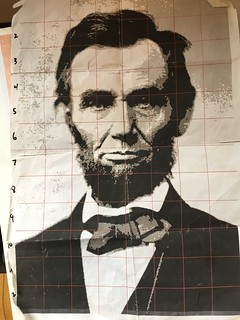

Schlatter created a working grid of the Gardner photograph on his backing board, then began to painstakingly select cents by color, and to glue each one on individually. Five pounds of glue were used to secure the cents, and at least 465 hours were consumed to secure them to the board. Much of the work had be done on a ladder-like platform, and it was necessary to retreat to ground level from time to time to observe how the newly-added cents appeared from a distance.
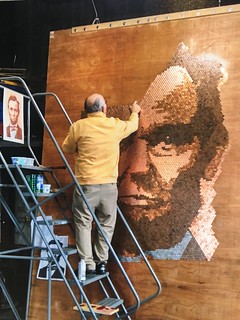
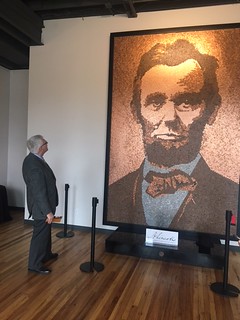
Left: Schlatter Creating; Right: Orosz Observing
On October 27, 2017, I attended a meeting in Battle Creek of a private charitable foundation on the Board of which I serve, and upon the meeting’s conclusion, all Board members walked over to the offices of the Battle Creek Community Foundation, where Schlatter’s A. Lincoln is on public display until at least the end of calendar year 2017.
The sheer scale of the work impresses immediately, as the photos of the author of this article admiring the piece, as well as that of artist Richard Schlatter standing in front of it, will attest. Then your eye is drawn to the tremendous variations in color, ranging from burnt umber to rosy brown, to russet, chocolate, auburn, bronze, sepia, and copper. All of this is apparent from the traditional viewing vantage of 2-3 feet away from the piece. But, as you back away from it, the individual coins meld into a unified vision, so that when you are 15-20 feet away, A. Lincoln seems to have brush strokes, as if it were painted. Stand further away still, and borders between cents disappear, so that the work seems to have been photographed. If you move from side to side, the variations in light and viewing angles will bring to mind even more distinctive impressions.
I was fortunate to meet Richard Schlatter during my visit. Schlatter, who modestly refers to himself not as the “artist,” but rather as the “designer” of this inspiring portrait, has collected his share of coins in the past, and has built homages to “penny” collectors into A. Lincoln’s very fabric. At least one Lincoln cent of every date 1909-2017 can be found among the 24,500; along with two Indian cents, dated 1891 and 1901; and a solitary cent planchet (the 1909 Lincoln and the planchet, among other pieces, were donated to the project by Michigan State Numismatic Society past President Al Bobrofsky, also a resident of Battle Creek).
Schlatter told us about the challenges he faced in designing and creating A. Lincoln, not the least of which was the sheer physical demands that climbing, bending, and hauling placed upon the artist. It was annoying to occasionally drop buckets of carefully color-sorted cents upon the floor, and downright discouraging to step back and realize that several of just-glued cents did not look right, and must be removed and re-glued. There were times when, aching and disheartened, he contemplated abandoning the project. During such times, however, the words of the late coach Jim Valvano at the 1993 ESPY awards kept coming back to him: “Never give up….don’t ever give up.”
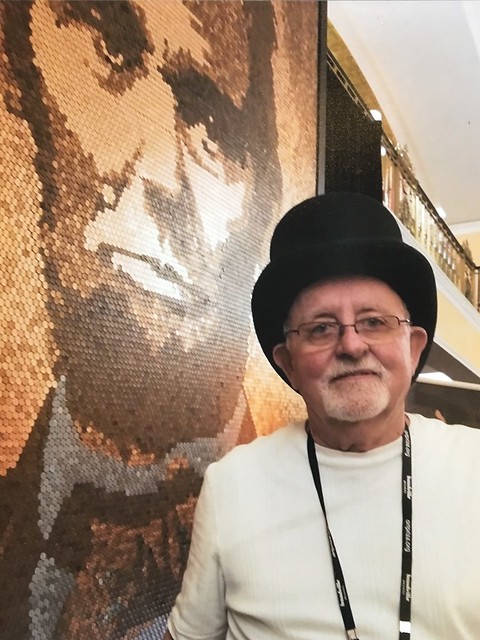
Richard Schlatter
We can be thankful that Schlatter listened to the late coach Valvano. The ArtPrize visitors of 2017 were right to select this impressive portrait of “Lincoln made of Abrahams” as the Public Vote Grand Prize Winner. For now, A. Lincoln remains the property of the artist, but offers are on the table from both private collectors and public institutions to eventually provide it a more lasting home. Battle Creek is just north of Interstate-94, about halfway between Detroit and Chicago. It would repay any numismatist traveling or residing within a wide radius of the Cereal City to see the 96 square feet of A. Lincoln while it is still on free public display at the Battle Creek Community Foundation, through at least the end of this year.
Joel adds:
The artwork really has to be seen to be fully appreciated. I would have made Mr. Schlatter an offer for it, except that I would also have to buy a new house, since I literally don't have a wall big enough to hang this behemoth!
To read the earlier E-Sylum article, see:
ARTIST WINS AWARD FOR LINCOLN PENNY PORTRAIT (http://www.coinbooks.org/v20/esylum_v20n43a22.html)
FEATURED WEB SITE: ARTMEDAL.NET
This week's Featured Web Site is artMedal.net.This website is dedicated to all those art medals, which are hidden in safes or safe deposit boxes - although of no great monetary value. May at least their images delight some of the visitors of this website.
Here you can see art medals and plaques - many of them are art nouveau and art deco - from different countries. Additionally some works of contemporary medal artists from different countries are shown in special parts of this domain too.
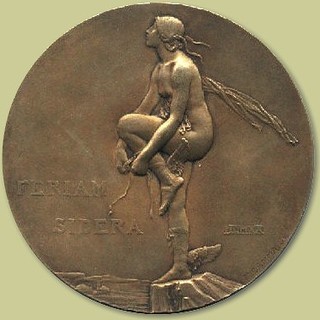
www.artmedal.net

